QuickLinks:
5350, 5351, 5352, 5353, 5354, 5355, 5356, 5357, 5358, 5359, 5360, 5361, 5362, 5363, 5364, 5365, 5366,
5367, 5368, 5369, 5370, 5371, 5372, 5373, 5374, 5375, 5376, 5377, 5378, 5379, 5380, 5381, 5382, 5383,
5384, 5385, 5386, 5387, 5388, 5389, 5390, 5391, 5392, 5393, 5394, 5395, 5396, 5397, 5398, 5399
Page last updated Oct 22, 2021
(Completed current iteration; not at all "done", but much closer than before)
Updated "final" Corwin positions
Added enough images to provide "proper" classifications (not always as listed in references)
Did final check of Dreyer NGC entries, added selected designations for NGC objects (and some "companions")
Checked Gottlieb IDs, historical notes
Labeled and recorded basic info for "companions"
NEXT (later?): Check NGC notes, IC1/2 notes, 1912 notes
NGC 5350
(= HCG 68C)
(a member of Hickson Compact Group 68)
(= PGC 49347 = UGC 8810 = CGCG 219-017 = MCG +07-29-009)
Discovered (Jan 14, 1788) by William Herschel
Also observed (May 13, 1828) by John Herschel
A magnitude 11.3 spiral galaxy (type SB(rs)b?) in Canes Venatici (RA 13 53 21.6, Dec +40 21 50)
Historical Identification: Per Dreyer, NGC 5350 (= GC 3688 = JH 1696 = WH II 713, 1860 RA 13 47 26, NPD 48 56.3) is "considerably faint, pretty large, brighter middle, 7th magnitude star preceding (to the west), 1st of 4," the others being NGC 5353, 5354 and 5555.
Physical Information: A Seyfert galaxy, and a member of the NGC 5353 group of galaxies, also known as Hickson Compact Group 68. Based on a recessional velocity of 2320 km/sec, NGC 5350 is about 110 million light years away, in good agreement with redshift-independent distance estimates of 90 to 125 million light years. Given that and its apparent size of 3.2 by 2.3 arcmin, it is about 100 thousand light years across.
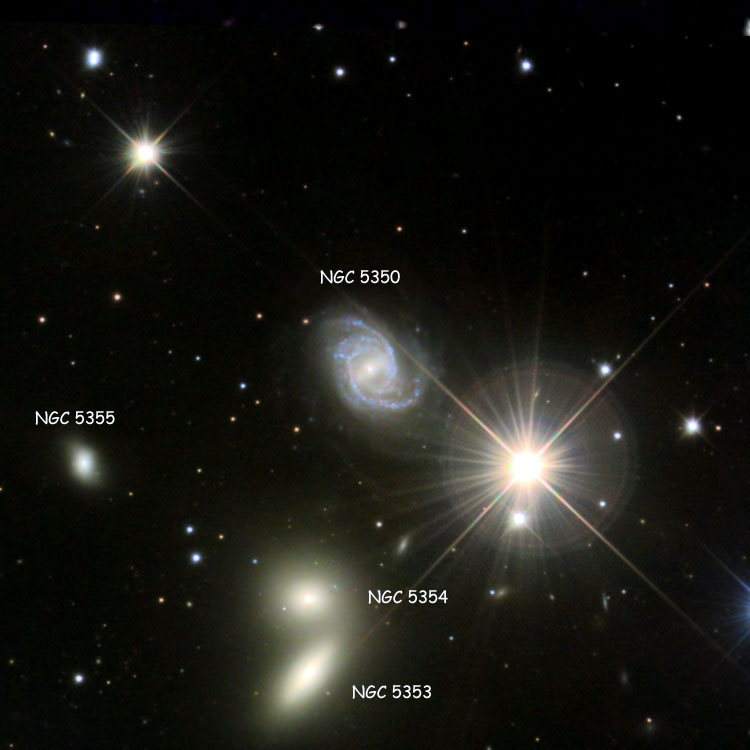
Above, a 12 arcmin wide image centered on NGC 5350; the nearby star is 6th magnitude HD 121197
(Image Credit & © Jim Misti, Misti Mountain Observatory; used by permission)
Below, a 3 arcmin wide SDSS image of the galaxy

Below, a 12 arcmin wide view of Hickson Compact Group 68 (= NGC 5350, 5353, 5354, 5355 and 5358)
(Image Credit & © Jim Misti, Misti Mountain Observatory; used by permission)
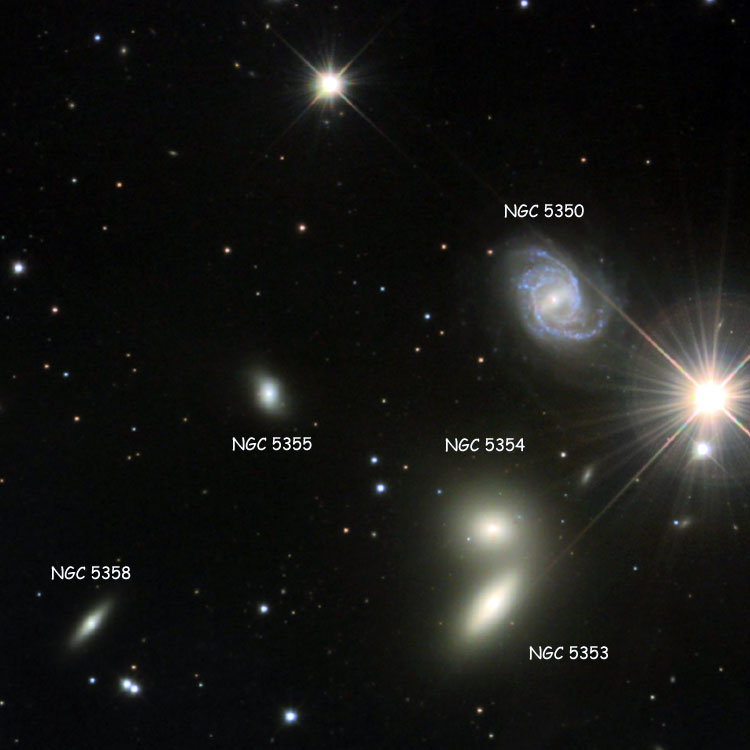
NGC 5351
(= PGC 49359 = UGC 8809 = CGCG 190-073 = CGCG 191-008 = MCG +06-31-008)
Discovered (May 16, 1787) by William Herschel
Also observed (Apr 28, 1827) by John Herschel
A magnitude 12.1 spiral galaxy (type S(rs)bc?) in Canes Venatici (RA 13 53 27.7, Dec +37 54 54)
Historical Identification: Per Dreyer, NGC 5351 (= GC 3689 = JH 1697 = WH II 697, 1860 RA 13 47 26, NPD 51 23.7) is "considerably faint, large, a little extended 90°, very gradually brighter middle."
Physical Information:
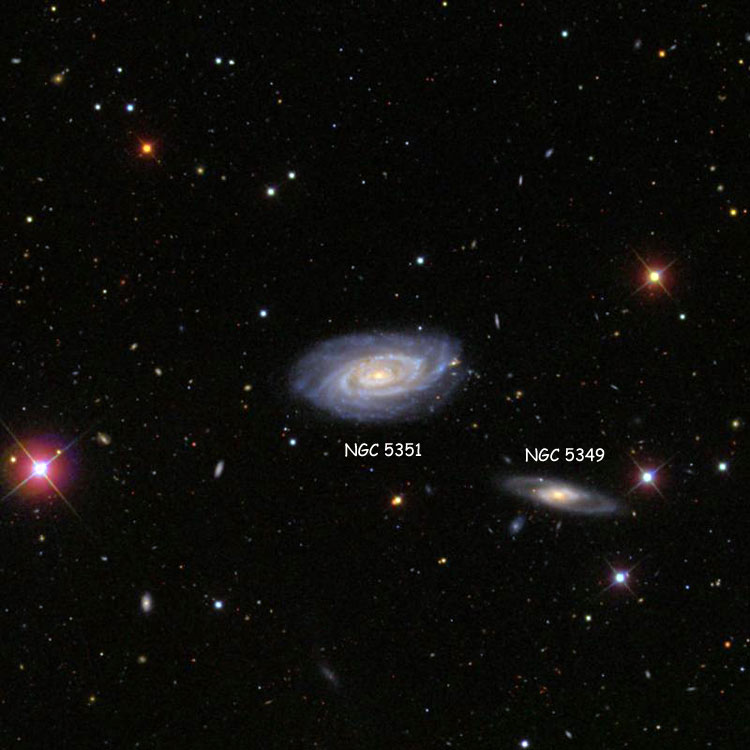
Above, a 12 arcmin wide SDSS image centered on NGC 5351, also showing NGC 5349
Below, a 3 arcmin wide SDSS image of the galaxy
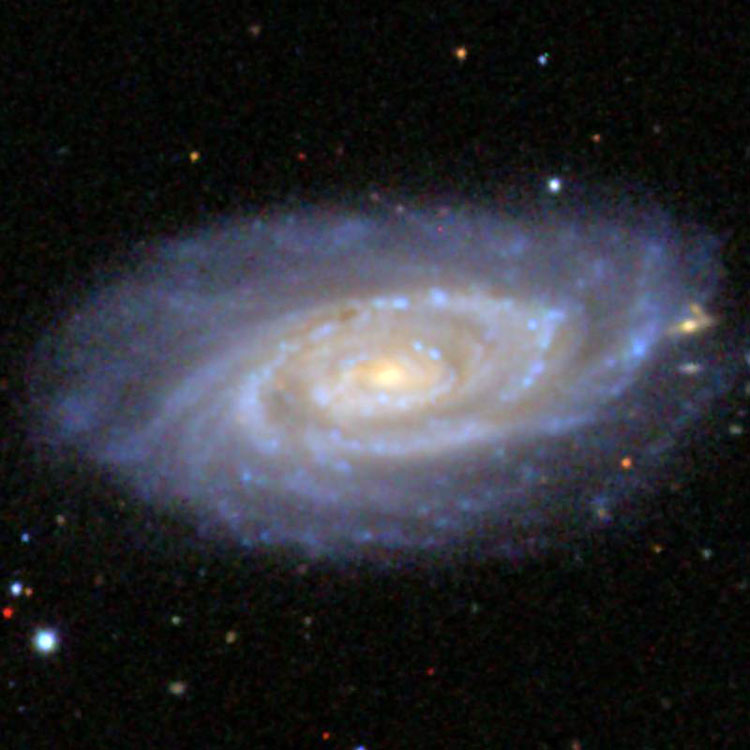
Below, a ? arcmin wide image of the region between NGC 5351 and NGC 5349
(Image Credit Teresa Hawes and Philip Darling/Adam Block/NOAO/AURA/NSF)

NGC 5352
(= PGC 49370 = UGC 8812 = CGCG 191-009 = MCG +06-31-011)
Discovered (May 1, 1785) by William Herschel
Also observed (Apr 24, 1827) by John Herschel
A magnitude 13.0 lenticular galaxy (type E/S0? pec) in Canes Venatici (RA 13 53 38.4, Dec +36 08 03)
Historical Identification: Per Dreyer, NGC 5352 (= GC 3692 = JH 1700 = WH II 415, 1860 RA 13 47 32, NPD 53 10.1) is "considerably faint, small, round, a little brighter middle, star 90" north-following (to northeast)."
Physical Information: Apparent size 2.1 by 1.2 arcmin.

Above, a 12 arcmin wide SDSS image centered on NGC 5352
Below, a 2.4 arcmin wide SDSS image of the galaxy

NGC 5353 (= HCG 68A)
(A member of Hickson Compact Group 68)
(= PGC 49356 = UGC 8813 = CGCG 219-018 = MCG +07-29-010)
Discovered (Jan 14, 1788) by William Herschel
Also observed (May 12, 1828) by John Herschel
A magnitude 11.0 lenticular galaxy (type SAB0/a?) in Canes Venatici (RA 13 53 26.7, Dec +40 16 59)
Historical Identification: Per Dreyer, NGC 5353 (= GC 3693 = JH 1698 = WH II 714, 1860 RA 13 47 32, NPD 49 01.6) is "pretty bright, small, round, 2nd of 4," the others being NGC 5350, 5354 and 5355.
Physical Information: The brightest member of the NGC 5353 group of galaxies (also known as Hickson Compact Group 68), NGC 5353 is paired with NGC 5354. Based on a recessional velocity of 2325 km/sec, NGC 5353 is about 110 million light years away, in fair agreement with a redshift-independent distance estimate of 125 million light years. Given that and its apparent size of 2.2 by 1.1 arcmin, it is about 70 thousand light years across.
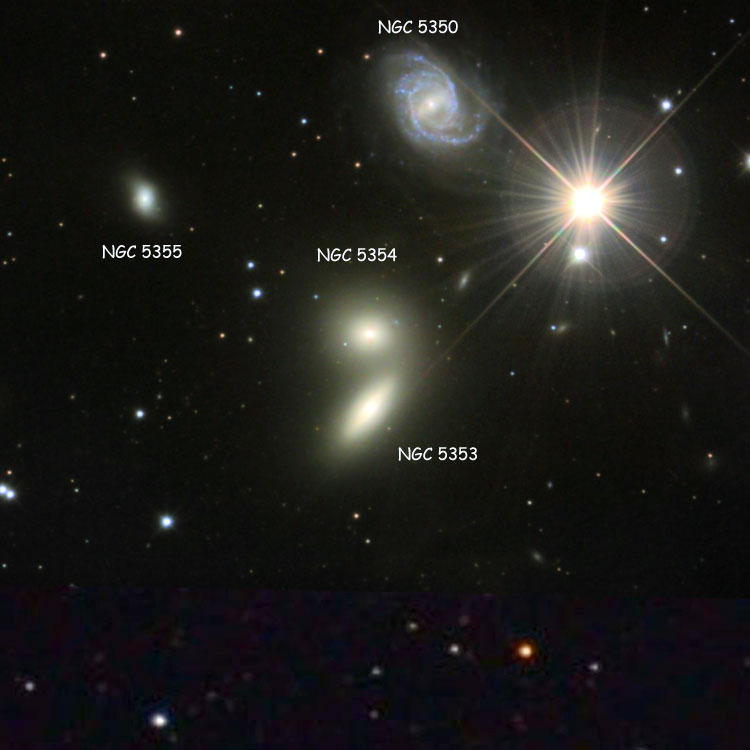
Above, a 12 arcmin wide composite image centered on NGC 5353 and 5354
(the nearby star is 6th-magnitude HD 121197)
(Image Credit & © above and below Jim Misti, Misti Mountain Observatory on SDSS background; used by permission)
Below, a 3 arcmin wide image of NGC 5353 and 5354
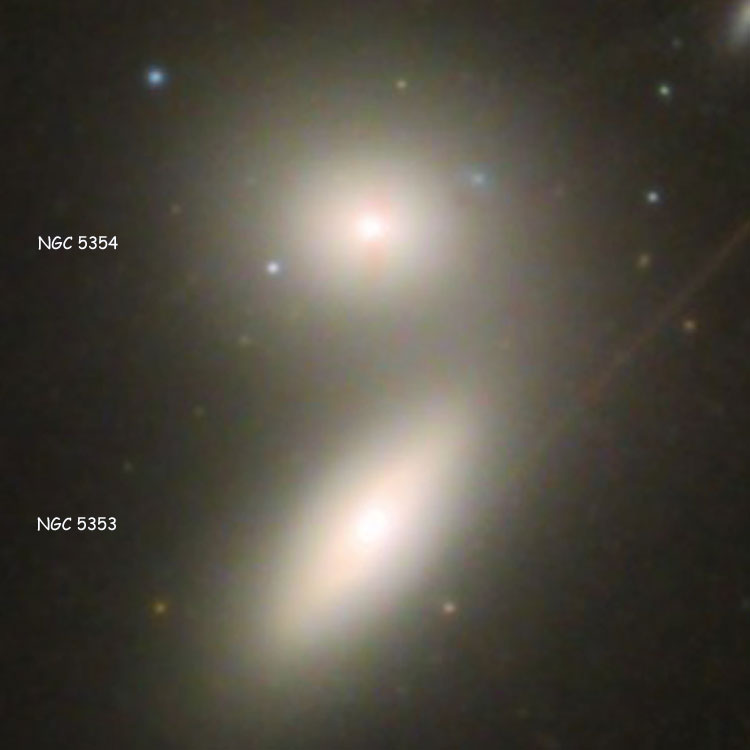
Below, a 12 arcmin wide view of Hickson Compact Group 68 (= NGC 5350, 5353, 5354, 5355 and 5358)
(Image Credit © Jim Misti, Misti Mountain Observatory; used by permission)

NGC 5354 (= HCG 68B)
(A member of Hickson Compact Group 68)
(= PGC 49354 = UGC 8814 = CGCG 219-019 = MCG +07-29-011)
Discovered (Jan 14, 1788) by William Herschel
Also observed (May 12, 1828) by John Herschel
A magnitude 11.4 lenticular galaxy (type S0/a?) in Canes Venatici (RA 13 53 26.7, Dec +40 18 10)
Historical Identification: Per Dreyer, NGC 5354 (= GC 3694 = JH 1699 = WH II 715, 1860 RA 13 47 32, NPD 49 00.4) is "pretty faint, small, round, 3rd of 4," the others being NGC 5350, 5353 and 5355.
Physical Information: A member of the NGC 5353 group of galaxies (also known as Hickson Compact Group 68), and paired with that galaxy (which see for images). Based on a recessional velocity of 2580 km/sec, NGC 5354 is about 120 million light years away. Given that and its apparent size of 1.4 by 1.3 arcmin, it is about 50 thousand light years across.
NGC 5355 (= HCG 68D)
(A member of Hickson Compact Group 68)
(= PGC 49380 = UGC 8819 = CGCG 219-020 = MCG +07-29-012)
Discovered (Jan 14, 1788) by William Herschel
Also observed (May 12, 1828) by John Herschel
A magnitude 13.1 lenticular galaxy (type S0(s)a?) in Canes Venatici (RA 13 53 45.6, Dec +40 20 19)
Historical Identification: Per Dreyer, NGC 5355 (= GC 3695 = JH 1702 = WH III 699, 1860 RA 13 47 45, NPD 48 57.6) is "very faint, pretty small, 4th of 4," the others being NGC 5350, 5353 and 5354.
Physical Information: Based on a recessional velocity of 2345 km/sec (and H0 = 70 km/sec/Mpc), NGC 5355 is about 110 million light years away. Given that and its apparent size of about 1.05 by 0.6 arcmin (from the images below), it is about 30 to 35 thousand light years across. It is a member of the NGC 5353 group of galaxies (also known as Hickson Compact Group 68).

Above, a 12 arcmin wide image of Hickson Compact Group 68 (= NGC 5350, 5353, 5354, 5355 and 5358)
(Image Credit & © above and below: Jim Misti, Misti Mountain Observatory on SDSS background; used by permission)
Below, a 1.4 arcmin wide image of the galaxy (Composite of SDSS and Misti Mountain images)
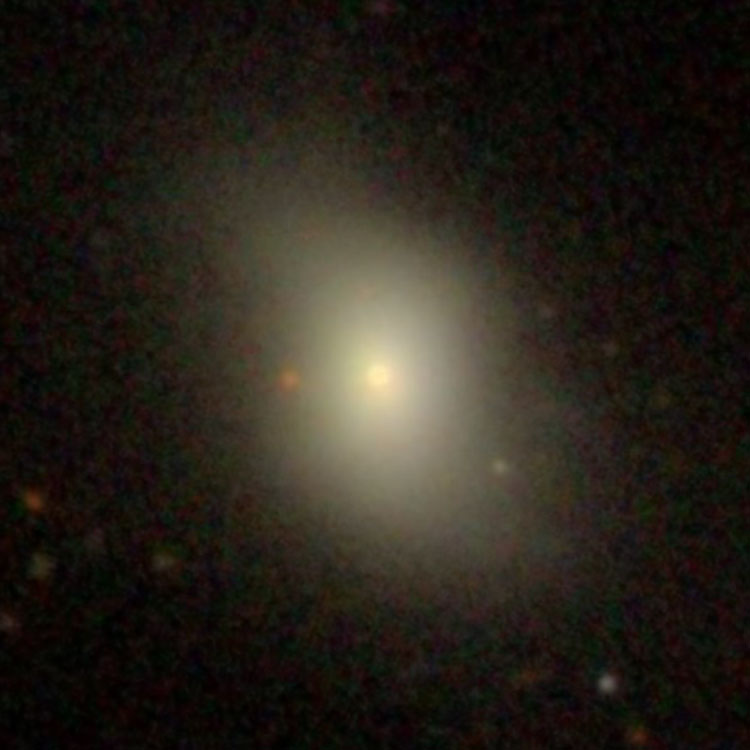
NGC 5356
(= PGC 49468 = UGC 8831 = CGCG 046-001 = MCG +01-35-052)
Discovered (Feb 2, 1786) by William Herschel
Also observed (Apr 9, 1828) by John Herschel
Also observed (Apr 14, 1852) by Bindon Stoney
A magnitude 12.6 spiral galaxy (type SBbc?) in Virgo (RA 13 54 58.4, Dec +05 20 01)
Historical Identification: Per Dreyer, NGC 5356 (= GC 3696 = GC 3698 = JH 1701 = WH III 506, 1860 RA 13 47 56, NPD 83 58.7) is "faint, pretty large, very much extended 17°, mottled but not resolved."
Physical Information: Apparent size 3.5 by 0.8 arcmin?

Above, a 12 arcmin wide SDSS image centered on NGC 5356
Below, a 4 arcmin wide SDSS image of the galaxy

NGC 5357
(= PGC 49534 = ESO 445-078 = MCG -05-33-032)
Discovered (Mar 30, 1835) by John Herschel
Looked for but not found (1899 - 1902) by Robert Innes
A magnitude 12.0 elliptical galaxy (type E2) in Centaurus (RA 13 55 59.5, Dec -30 20 29)
Historical Identification: Per Dreyer, NGC 5357 (= GC 3697 = JH 3546, 1860 RA 13 47 58, NPD 119 38.9) is "pretty faint, small, round, gradually a little brighter middle, between two 10th magnitude stars." The second IC notes "Not found by Innes (7-inch refractor)."
SEE CORWIN NOTE FOR THIS OBJECT
Physical Information: Apparent size of about 1.4 by 1.1 arcmin (from the images below)
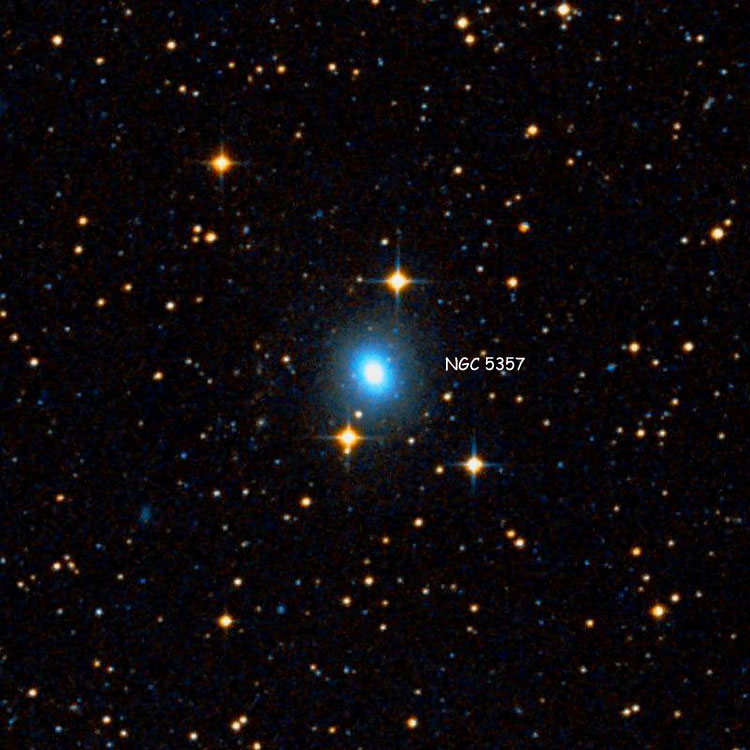
Above, a 12 arcmin wide DSS image centered on NGC 5357
Below, a 2.4 arcmin wide DSS image of the galaxy

Below, a 2 arcmin wide PanSTARRS image of the galaxy; despite the many artifacts, its physical nature and size are obvious

Below, the central 0.3 arcmin of the image above
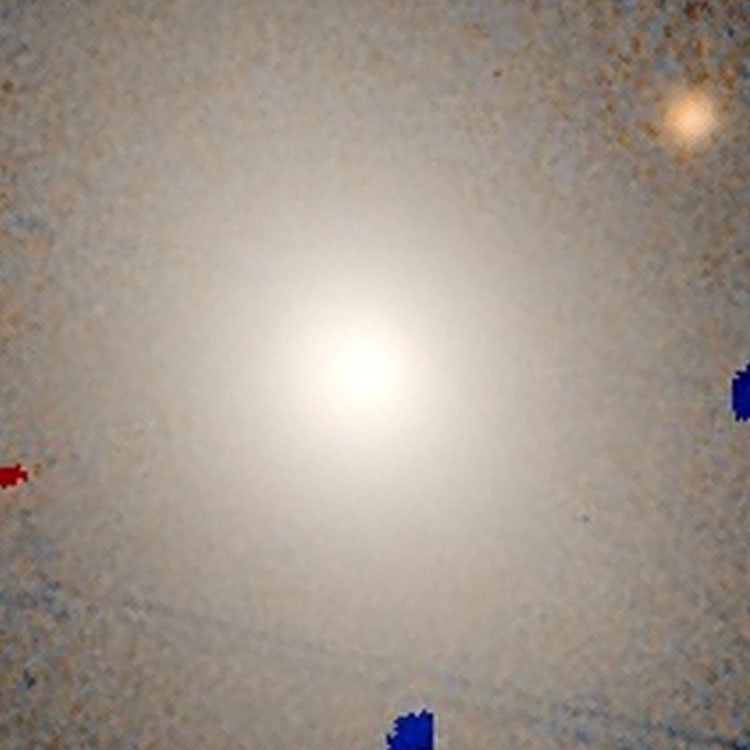
NGC 5358 (= HCG 68E)
(A member of Hickson Compact Group 68)
(= PGC 49389 = UGC 8826 =CGCG 219-022 = MCG +07-29-013)
Discovered (Jun 23, 1880) by Édouard Stephan
Also observed (Jun 3, 1883) by Hermann Vogel
A magnitude 13.6 lenticular galaxy (type S0/a??) in Canes Venatici (RA 13 54 00.4, Dec +40 16 38)
Historical Identification: Per Dreyer, NGC 5358 (Stephan list XI (b#1), Vogel, 1860 RA 13 48 05, NPD 49 01.9) is "very faint, very small, round, 2 very faint stars involved."
Discovery Note: Gottlieb lists this as Stephan XI #21, but Stephan's list XI is a combination of his lists XIa and XIb, and XIb#1 is the same object.
Physical Information: A member of the NGC 5353 group of galaxies (also known as Hickson Compact Group 68). Based on a recessional velocity of 2400 km/sec, NGC 5358 is about 110 million light years away. Given that and its apparent size of 1.25 by 0.5 arcmin, it is about 40 thousand light years across.
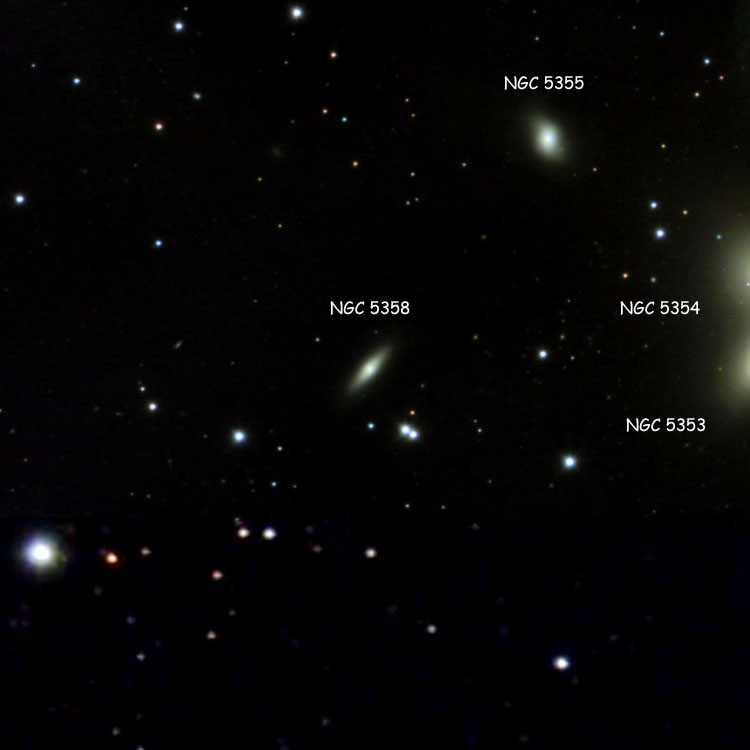
Above, a 12 arcmin wide image centered on NGC 5358, also showing NGC 5353, 5354 and 5355
(Image Credit & © above and below Jim Misti, Misti Mountain Observatory on SDSS background; used by permission)
Below, a 2.4 arcmin wide image of the galaxy
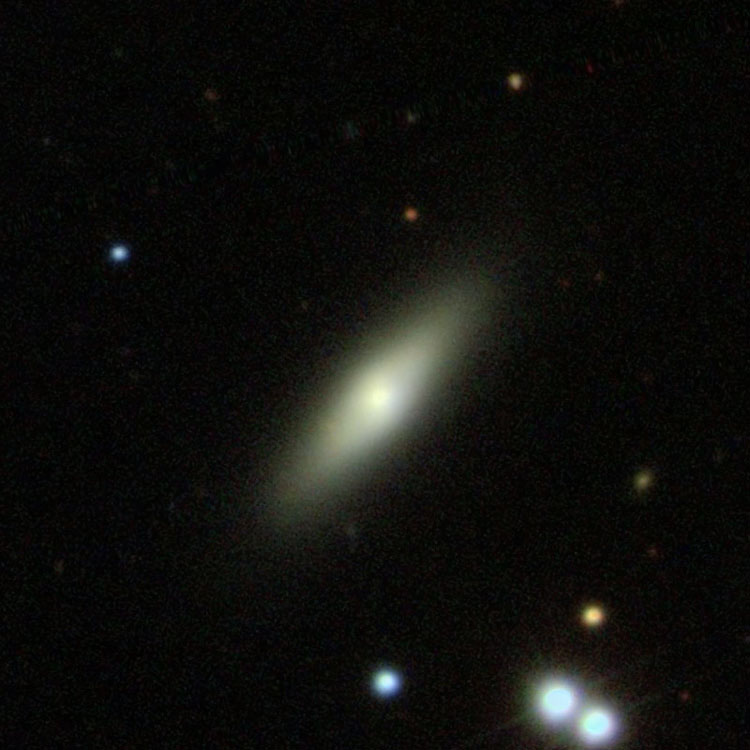
Below, a 12 arcmin wide view of Hickson Compact Group 68 (= NGC 5350, 5353, 5354, 5355 and 5358)
(Image Credit & © Jim Misti, Misti Mountain Observatory; used by permission)

NGC 5359
(= "PGC 3518315" = ESO 066-SC004)
Discovered (May 17, 1835) by John Herschel
A magnitude 13.7(?) open cluster (or two) in Circinus (RA 14 00 07, Dec -70 23 06)
SEE CORWIN NOTE FOR THIS OBJECT
Historical Identification: Per Dreyer, NGC 5359 (= GC 3699 = JH 3545, 1860 RA 13 48 31, NPD 159 43.3) is "a cluster, very large, a little rich, a little compressed, stars of 11th magnitude."
Note About PGC Designation: As for most NGC objects, HyperLEDA assigned a PGC designation to this object, even though it isn't a galaxy; but a search of the database for that designation returns no result, so it is shown in quotes.
Physical Information:
Corwin lists NGC 5359.1 (presumably part of or a similar group) at RA 14 00 15.0, Dec -70 19 54
and a "ne grp" that is part of NGC 5359 at RA 14 01 27.0, Dec -70 18 06
and NGC 5359.2 at RA 14 00 07.0, Dec -70 23 06

Above, a 12 arcmin wide DSS image centered on NGC 5359
NGC 5360 (probably = IC 958)
(= PGC 49513 = UGC 8838 = CGCG 046-003 = MCG +01-36-001)
Discovered (May 8, 1864) by Albert Marth (and later listed as NGC 5360)
Discovered (Apr 19, 1890) by Lewis Swift (and later listed as IC 958)
A magnitude 13.3 spiral galaxy (type SBd? pec) in Virgo (RA 13 55 38.4, Dec +04 59 05)
Historical Identification: Per Dreyer, NGC 5360 (= GC 5751, Marth #268, 1860 RA 13 48 34, NPD 84 18) is "very faint, very small, a little extended." The position precesses to RA 13 55 36.1, Dec +05 00 43, about 1.8 arcmin north northwest of the galaxy listed above, the description fits and there is nothing else nearby, so the identification is certain. (See IC 958 for a discussion of the probable double entry.)
Physical Information: Based on a recessional velocity of 1170 km/sec (and H0 = 70 km/sec/Mpc), NGC 5360 is about 55 million light years away, somewhat closer than a pair of redshift-independent distance estimates of about 70 to 75 million light years, but about the same distance as its probable companion (it is thought to be a physical pair with NGC 5364, and a gravitational interaction between them may be responsible for the slightly peculiar appearance of each galaxy). Given that and its apparent size of about 1.3 by 0.4 arcmin (from the images below), it is about 20 thousand light years across.
Classification Note: LEDA classifies this as a peculiar lenticular SB0/a galaxy, while NED lists it as type I0 (somewhere between a lenticular and an irregular galaxy). It is clearly a peculiar galaxy, but the long central "bar" indicative of active star-formation, and extensive clouds of interstellar dust scattered by its probable interaction with NGC 5364, feel more like a peculiar spiral galaxy seen edge-on to me than either an irregular or lenticular galaxy, which would be unlikely to have such a long central bar if irregular, and less scattered all around if lenticular. But no matter what classification is chosen, a number of question marks would undoubtedly be required to indicate the uncertainty associated with that classification.

Above, a 12 arcmin wide SDSS image centered on NGC 5360
Below, a 1.6 arcmin wide SDSS image of the galaxy

Below, a 12 arcmin wide image centered between NGC 5364 and NGC 5360
(Image Credit & © Adam Block/Mount Lemmon SkyCenter/University of Arizona; used by permission)
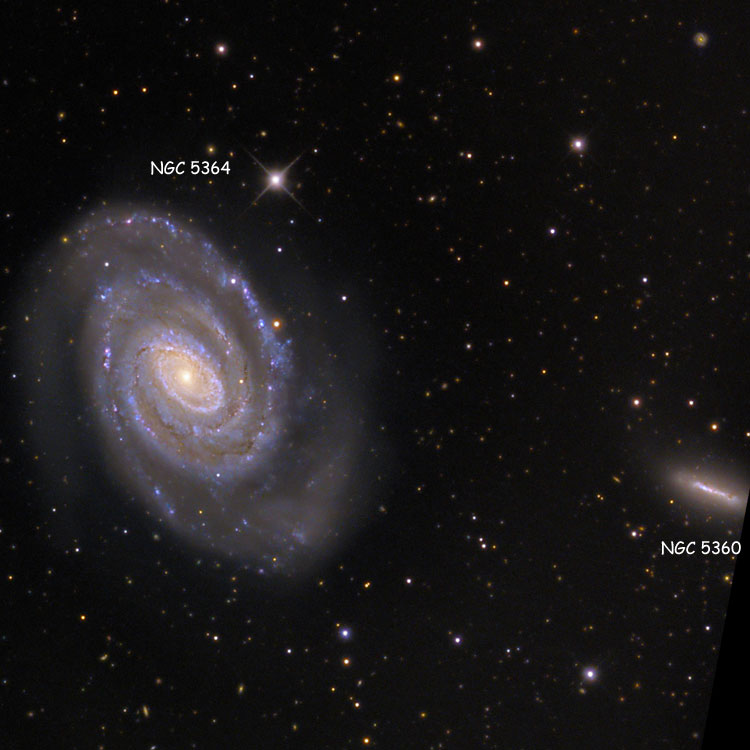
NGC 5361
(= PGC 49441 = CGCG 219-025 = MCG +07-29-015)
Discovered (May 16, 1787) by William Herschel
A magnitude 13.9 spiral galaxy (type S(rs)bc?) in Canes Venatici (RA 13 54 35.2, Dec +38 26 58)
Historical Identification: Per Dreyer, NGC 5361 (= GC 3700 = WH III 682, 1860 RA 13 48 39, NPD 50 52.9) is "extremely faint, considerably small, extended."
Physical Information: LEDA S0/a, NED S?, 3K Vr 5840 km/sec; apparent size of about 0.75 by 0.35 arcmin (from the images below)

Above, a 12 arcmin wide SDSS image centered on NGC 5361
Below, a 1 arcmin wide SDSS image of the galaxy
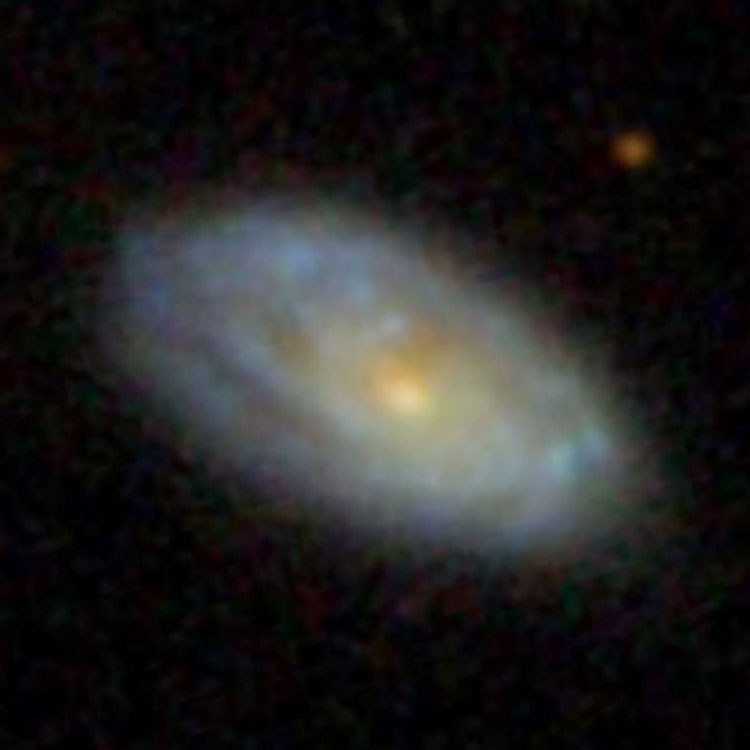
NGC 5362
(= PGC 49464 = UGC 8835 = CGCG 219-026 = MCG +07-29-016)
Discovered (Apr 9, 1787) by William Herschel
A magnitude 12.3 spiral galaxy (type SA(s)bc?) in Canes Venatici (RA 13 54 53.3, Dec +41 18 48)
Historical Identification: Per Dreyer, NGC 5362 (= GC 3701 = WH II 671, 1860 RA 13 48 59, NPD 48 03.4) is "pretty bright, pretty large, extended." The position precesses to RA 13 54 51.4, Dec +41 15 18, nearly 3.6 arcmin south of the galaxy listed above, but the description fits and there is nothing else nearby, so the identification is considered certain.
Physical Information: Based on a recessional velocity relative to the Cosmic Microwave Background of 2365 km/sec (and H0 = 70 km/sec/Mpc), NGC 5362 is about 110 million light years away, in good agreement with redshift-independent distance estimates of about 75 to 125 million light years. Given that and its apparent size of about 2.0 by 0.7 arcmin (from the images below), it is about 65 thousand light years across. (Note: The galaxy type has a question mark because Corwin describes it as "a lovely SA(s)bc or c spiral", and I've only used the first description as its type.)

Above, a 12 arcmin wide SDSS image centered on NGC 5362, also showing companion "PGC 4074750"
Below, a 2.4 arcmin wide SDSS image of the pair

"PGC 4074750"
(= SDSS J135453.52+411835.8)
Not an NGC object but listed here as an interacting companion of NGC 5362
A magnitude 16(?) spiral galaxy (type Scd? pec) in Canes Venatici (RA 13 54 53.5, Dec +41 18 32)
Note About PGC Designation: As for most NGC objects, HyperLEDA assigned a PGC designation to this object, even though it isn't a galaxy; but a search of the database for that designation returns no result so it is shown in quotes. , and showing the (SDSS) designation needed to find the object in HyperLEDA. As it turns out, NED will display a page for the object if PGC 4074750 is changed to LEDA 4074750; this is the default NED method of treating HyperLEDA designations for all objects that were not in the original Principal Galaxy Catalog, but doesn't usually work for such an extremely high PGC designation, so it is surprising that it does work in this case.
Note About Classification: Different references list different types, ranging from Sbc to Sm; and since the galaxy is so small and higher-quality images are not currently available, all that can be said is that it is some kind of spiral, and if it could be seen in detail, would probably exhibit some peculiarity due to its interaction with its companion.
Physical Properties: Based on a recessional velocity relative to the Cosmic Microwave Background of 2360 km/sec (and H0 = 70 km/sec/Mpc), "PGC 4074750" is about 110 million light years away, or at essentially the same distance as its companion, NGC 5362. Given that and its apparent size of about 0.3 by 0.18 arcmin (from the image below), it is about 9 or 10 thousand light years across, or a "dwarf" spiral. It is undoubtedly a physical companion interacting with NGC 5362, though there seems to be some confusion about its position relative to its companion, as most references state that it is in front of and superimposed on NGC 5362, whereas the image below shows that the southernmost arm of NGC 5362 is clearly in front of the smaller galaxy, meaning that it must be (very slightly) in back of the larger galaxy, not in front.
Odds are that the common error stating that the dwarf spiral is in front of the normal one is a result of the fact that the recessional velocity of the smaller galaxy is (very slightly) smaller than that of its companion. However, "peculiar velocities" (random motions of galaxies relative to their neighbors) typically range from a few dozen to a few hundred km/sec, so the 5 km/sec difference in the measured recessional velocities of the galaxies is meaningless, and as stated above there is absolutely no doubt that NGC 5362 lies in front of its companion, not behind it.
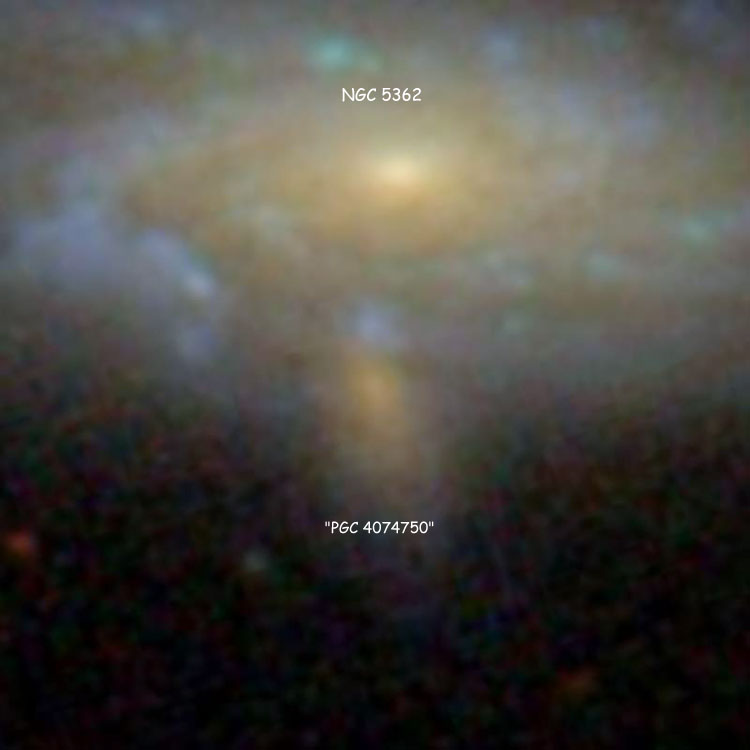
Above, a 1 arcmin wide SDSS image of "PGC 4074750" and its companion, NGC 5362 (which see)
NGC 5363
(= PGC 49547 = UGC 8847 = CGCG 046-007 = MCG +01-36-002)
Discovered (Jan 19, 1784) by William Herschel
Also observed (Apr 9, 1828) by John Herschel
A magnitude 10.1 lenticular galaxy (type S0/a?) in Virgo (RA 13 56 07.2, Dec +05 15 18)
Historical Identification: Per Dreyer, NGC 5363 (= GC 3702 = JH 1703 = WH I 6, 1860 RA 13 49 05, NPD 84 03.5) is "bright, pretty large, round, pretty suddenly brighter middle, 8th magnitude star north-following (to northeast)."
Physical Information:
Use By The de Vaucouleurs Atlas: NGC 5363 is used by the de Vaucouleurs Atlas of Galaxies as an example of type I0 pec or E (dust-lane).

Above, a 12 arcmin wide SDSS image centered on NGC 5363
NGC 5364 (probably = NGC 5317)
(= PGC 49555 = UGC 8853 = CGCG 046-009 = MCG +01-36-003)
Discovered (Feb 2, 1786) by William Herschel (and later listed as NGC 5364)
Also observed (Apr 10, 1828) by John Herschel (and later listed as NGC 5364)
Also observed (Apr 14, 1852) by Bindon Stoney (and later listed as NGC 5364)
Discovered (Apr 7, 1828) by John Herschel (and later listed as NGC 5317)
A magnitude 10.5 spiral galaxy (type SA(rs)bc pec) in Virgo (RA 13 56 12.0, Dec +05 00 54)
Historical Identification: Per Dreyer, NGC 5364 (= GC 3704 = GC 3703 = JH 1705 = WH II 534, 1860 RA 13 49 10, NPD 84 17.8) is "considerably faint, large, round, gradually brighter middle." The position precesses to RA 13 56 12.0, Dec +05 00 58, almost dead center on the galaxy listed above, the description fits and there is nothing else nearby, to the identification is certain. (See NGC 5317 for a discussion of the duplicate entries.)
Discovery Note: As noted by Dreyer, GC 3703 is the same as GC 3704. The former observation was done by Bindon Stoney (while working as an assistant for the 3rd Lord Rosse, so that it is noted in the GC as a Rosse nova), while the latter was done by John Herschel. Hence the multiple credits for observations shown above.
Physical Information: A so-called "grand design" spiral galaxy, being an almost perfect representation of the "classic" structure; but with a substantial asymmetry in its outermost arms (whence the "pec" in its type) probably due to gravitational interaction with the relatively nearby NGC 5360. Based on a recessional velocity of 1240 km/sec (and H0 = 70 km/sec/Mpc), NGC 5364 is about 55 to 60 million light years away, in good agreement with widely spread redshift-independent distance estimates of about 30 to 85 million light years. Given that and its apparent size of about 6.4 by 3.2 arcmin for its brighter inner structure and about 6.4 by 5.6 arcmin for the fainter outer arms (from the images below), it is about 105 to 110 thousand light years across.
Use By The de Vaucouleurs Atlas: NGC 5364 is used by the de Vaucouleurs Atlas of Galaxies as an example of type SA(r)bc.
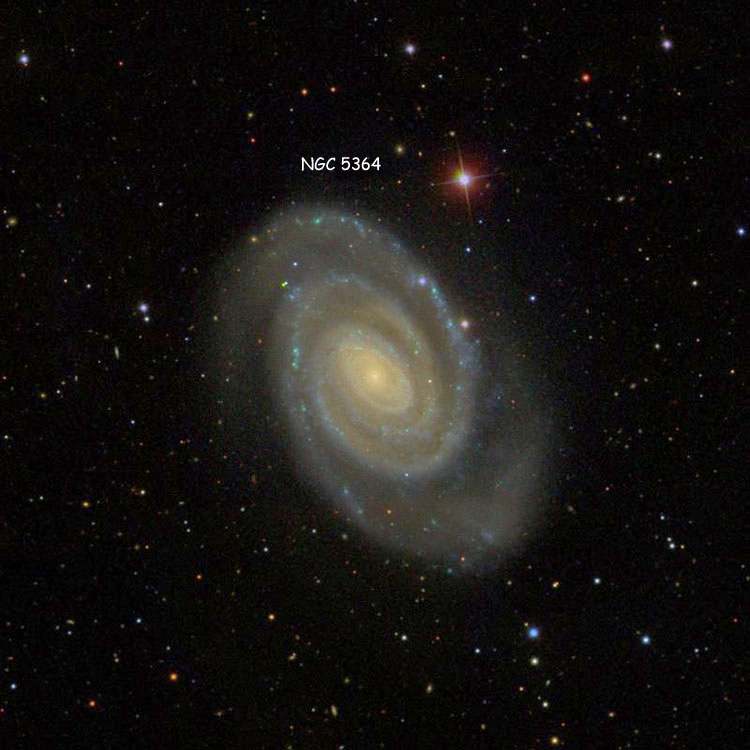
Above, a 12 arcmin wide SDSS image centered on NGC 5364
Below, a 12 arcmin wide image centered between NGC 5364 and NGC 5360
(Image Credit & © Adam Block/Mount Lemmon SkyCenter/University of Arizona; used by permission)

Below, a 7 arcmin wide image of the galaxy (Image Credit the same as for the image above)
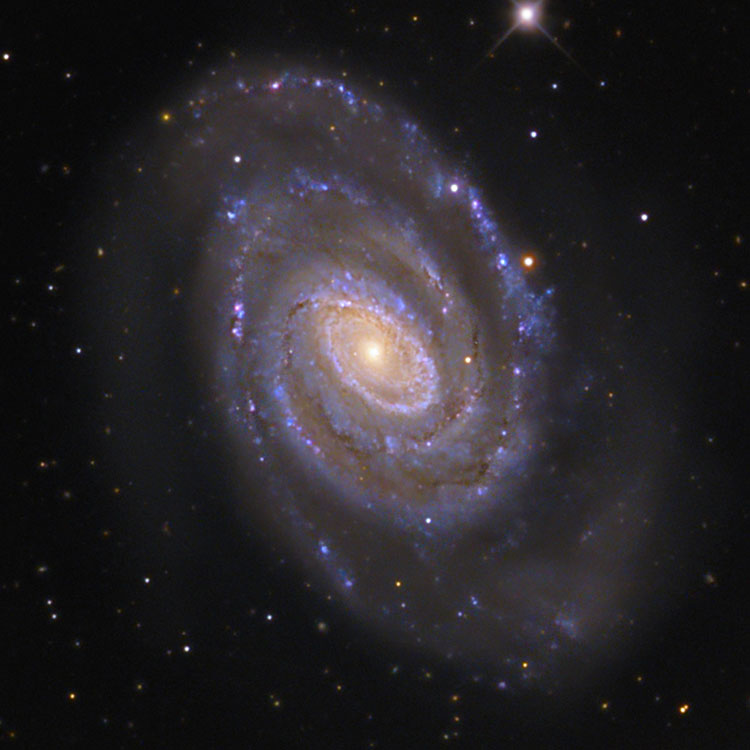
Below, a 0.75 by 0.8 arcmin wide image of the core of the galaxy
(Image Credit ESA/Hubble & NASA, L. Ho, P. Erwin et al.)

NGC 5365
(= PGC 49673 = PGC 542765 = ESO 271-008 = MCG -07-29-002)
Discovered (Mar 15, 1836) by John Herschel
A magnitude 11.4 lenticular galaxy (type (R)E/SB0 pec) in Centaurus (RA 13 57 50.6, Dec -43 55 52)
Historical Identification: Per Dreyer, NGC 5365 (= GC 3705 = JH 3547, 1860 RA 13 49 16, NPD 133 14.7) is "pretty bright, considerably small, round, pretty gradually brighter middle, among stars".
Physical Information: Apparent size 4.45 by 2.6 arcmin (from the images below).
Use By The de Vaucouleurs Atlas: NGC 5365 is used by the de Vaucouleurs Atlas of Galaxies as an example of galaxy type (R)SB0 -. The galaxy has two apparent bars: a bright one north-south, and a fainter one east-west. It may be that the fainter one is indicative of a polar ring galaxy; but in any case, it is certainly deserving of the addition of "pec" to the other attempts at classification.

Above, a 12 arcmin wide DSS image centered on NGC 5365
Below, a 4.5 arcmin wide DSS image of the galaxy

Below, a 3.5 by 4.75 arcmin wide monochome image of the galaxy
(Image Credit ESO/Kudzu; proper orientation and sizing by Courtney Seligman)
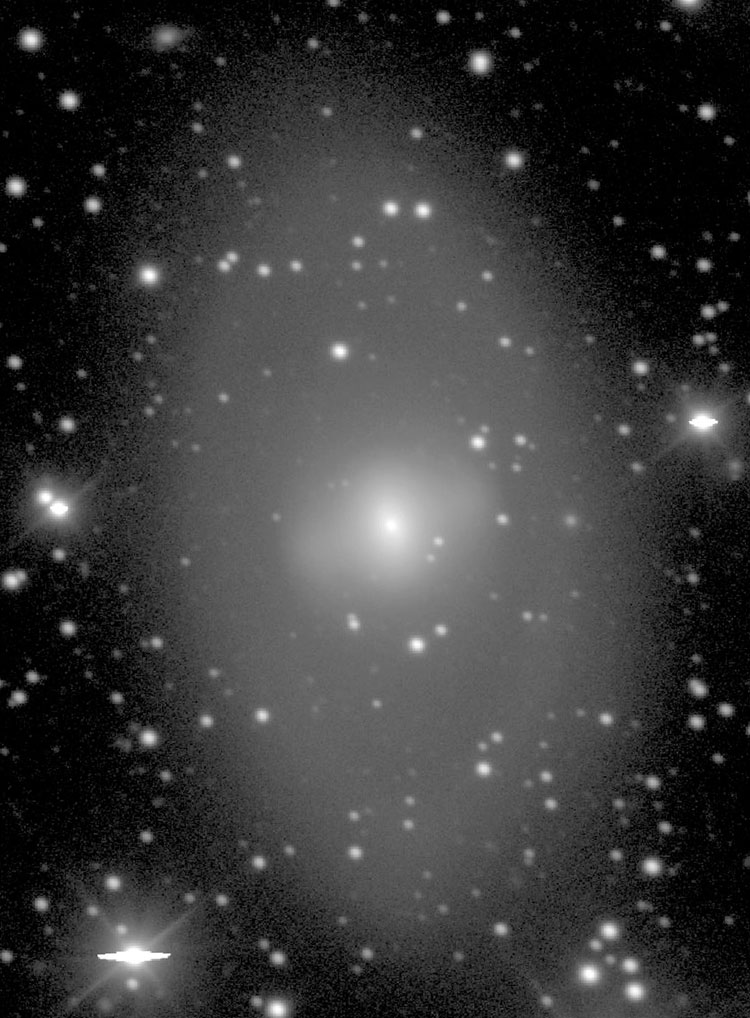
PGC 49586
(= PGC 49593 = ESO 271-006 = MCG -07-29-001 = "NGC 5365A")
Not an NGC object but listed here since sometimes called NGC 5365A
Discovered (May 18, 1881) by Joseph Turner
A magnitude 12.8 spiral galaxy (type SBb?) in Centaurus (RA 13 56 39.5, Dec -44 00 33)
Historical Note: Gottlieb states that although this galaxy was discovered by Turner prior to the publication of the NGC, the observation was never published, so Dreyer was unaware of the discovery, and it was not included in the NGC. (A recent review of the Great Melbourne Telescope logbooks was the source of this information.)
Physical Information: LEDA SBb; NED RIDE 29.7 - 38.0 Mpc, SBb? sp, 2.6 x .5 arcmin, 3K Vr 2991 km/sec
PGC 49750
(= ESO 271-009 = MCG -07-29-003 = "NGC 5365B")
Not an NGC object but listed here since sometimes called NGC 5365B
A magnitude 13.3 spiral galaxy (type Sab?) in Centaurus (RA 13 58 39.6, Dec -43 57 50)
Physical Information: LEDA Sab; NED Sab: sp, 1.6 x 0.3 arcmin, 3K Vr 2699 km/sec
NGC 5366
(= PGC 49569 = CGCG 018-007 = MCG +00-36-002)
Discovered (Jun 8, 1855) by George Bond
A magnitude 13.7 spiral galaxy (type (R')SAB(r's)bc? pec?) in Virgo (RA 13 56 24.9, Dec -00 14 51)
Historical Identification: Per Dreyer, NGC 5366 (= GC 5074, G. P. Bond (#18, HN 14), 1860 RA 13 49 19, NPD 89 31.2) is "small, round, 9th magnitude star 2 arcmin distant." The position precesses to RA 13 56 29.1, Dec -00 12 25, almost exactly on the 9th magnitude star about 2 arcmin north-northeast of the galaxy listed above, and since the position is reasonably accurate, the description is perfect, and there is nothing else in the region, the identification is certain.
Physical Information: LEDA SB0/a, NED (R')SB0^+(rs)?, 3K Vr 9178 km/sec, z 0.03061430179775. Odds are that NGC 5366 and its apparent companion are or were interacting, which would explain their somewhat peculiar appearance. Apparent size of main galaxy about 1.0 by 0.6 arcmin, very faint west-northwestern detached arc about 0.6 arcmin (from the images below)
Classification Note: Despite earlier classifications that list this as a barred lenticular galaxy, the images (below, and to be posted below) now available show that it is a tightly wound peculiar spiral. Both the inner and outer rings appear to be only partially complete (the outer one being formed by arms that nearly wrap around the galaxy), but still better images will be needed to remove any question marks from the type shown in the description line.

Above, a 12 arcmin wide SDSS image centered on NGC 5366, also showing probable companion PGC 49574
Below, a 1.5 arcmin wide SDSS image of the galaxy

PGC 49574
(= PGC 1147105 = CGCG 018-008 = MCG +00-36-003)
Not an NGC object but listed here as a probable companion of NGC 5366
A magnitude 16(?) spiral galaxy (type Sb?) in (RA 13 56 27.4, Dec -00 17 17)
Physical Information:LEDA Sbc, B 16.9 -> V 16(?); NED Sb, 3K Vr 9431 km/sec, z 0.03145692844658
NGC 5367 (= IC 4347)
(= "PGC 3517668" = ESO 325-N*036)
Discovered (Jun 26, 1834) by John Herschel (and later listed as NGC 5367)
Looked for (Jul 1, 1875) by Joseph Turner (while listed as JH 3548)
Discovered (Dec 30, 1897) by Lewis Swift (and later listed as IC 4347)
A reflection nebula in Centaurus (RA 13 57 44.0, Dec -39 58 46)
Historical Identification: Per Dreyer, NGC 5367 (= GC 3706 = JH 3548, 1860 RA 13 49 21, NPD 129 17.7) is "a remarkable object, very bright, very large, very little then very suddenly much brighter middle like a double star".
Discovery Note: Gottlieb states that Turner had a difficult time identifying the object on two nights, "including 1 Jul 1875, as he was expecting a fairly bright object." Turner stated that the object was much fainter than described by Herschel, and that the double star noted by Herschel as being near the center of the nebula was actually near its southeastern edge. The nebula is brighter and more extended to the west and southwest, so Turner probably did see what became NGC 5367, but presumed that it had significantly diminished in brightness, "as I cannot imagine that an 18 inch telescope could show it at present..." On the other hand, Swift stated that the star was in the center of "a nebulous atmosphere, whose outlines are as sharp as the planet Jupiter." Gottlieb also notes that Swift's position was essentially identical to that of Herschel, so Swift and Dreyer must have missed the fact that what became IC 4347 was the same object as NGC 5367.
Note About PGC Designation: As for most NGC objects, HyperLEDA assigned a PGC designation to this object, even though it isn't a galaxy; but a searach of the database for that designation returns no result, so it is shown in quotes.
Physical Information: NGC 5367 is the largest, brightest emission nebula in a region filled with absorption and emission nebulae. The half-degree wide image below shows the whole region, but none of the fainter features would have been visible to either Herschel or Swift, so that view is only shown for orientation

Above, a 30 arcmin wide DSS image centered on NGC 5367, showing the large region filled with emission and absorption nebulae
Below, a 12 arcmin wide DSS image centered on NGC 5367
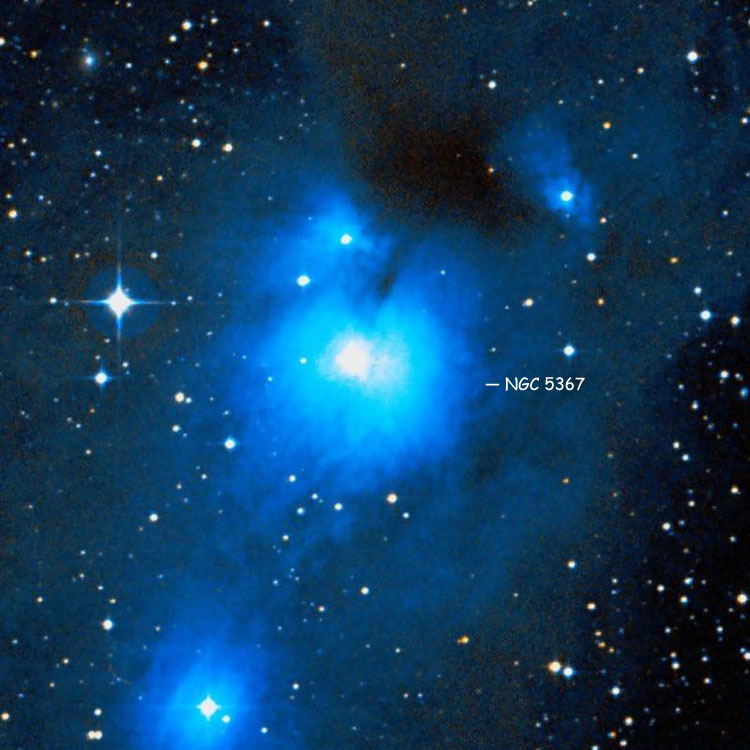
Corwin lists various positions for the stars and nebulae in the region
"5367n" at 13 57 44.4, -39 56 51
"5367ne" at 13 57 48.0, -39 57 30
"5367nw" at 13 57 26.1, -39 56 09
"5367se" at 13 57 56.0, -40 04 19
NGC 5368
(= PGC 49431 = UGC 8834 = CGCG 272-012 = MCG +09-23-014)
Discovered (Apr 14, 1789) by William Herschel
Also observed (May 2, 1831) by John Herschel
A magnitude 13.0 spiral galaxy (type (R)SB(rs)ab?) in Ursa Major (RA 13 54 29.2, Dec +54 19 50)
Historical Identification: Per Dreyer, NGC 5368 (= GC 3707 = JH 1706 = WH III 786, 1860 RA 13 49 24, NPD 34 58.6) is "faint, considerably small, round, stellar, 16th magnitude star north-following (to northeast)." The position precesses to RA 13 54 30.4, Dec +54 20 06, on the northeastern rim of the galaxy listed above, there is nothing else nearby and the (13th magnitude) star to the north northeast makes the identification certain.
Physical Information: Based on a recessional velocity of 4655 km/sec, NGC 5368 is about 215 million light years away. Given that and its apparent size of 0.95 by 0.7 arcmin, it is about 60 thousand light years across.
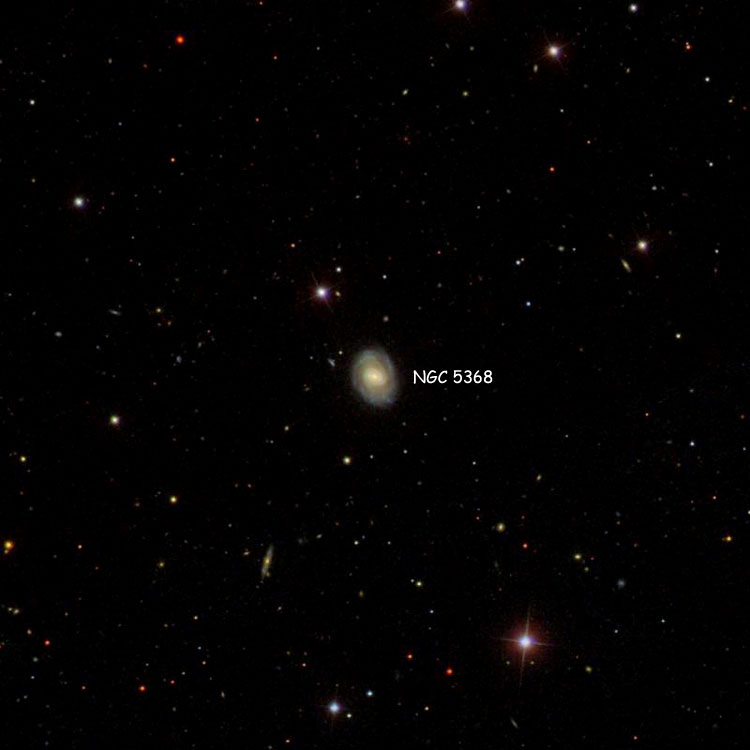
Above, a 12 arcmin wide SDSS image centered on NGC 5368
Below, a 1.2 arcmin wide SDSS image of the galaxy
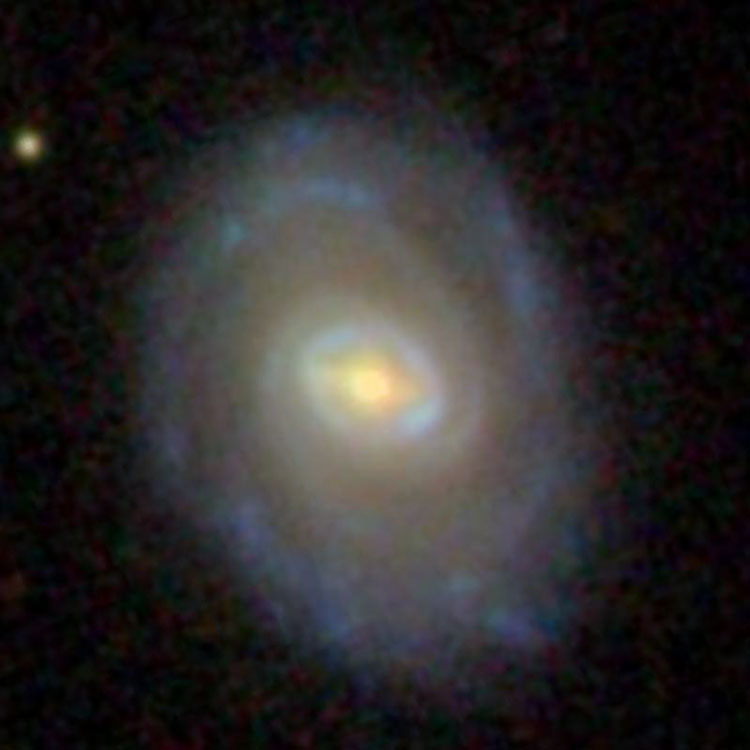
NGC 5369
(= PGC 49583)
Discovered (Mar 5, 1785) by William Herschel
Also observed (Apr 16, 1828) by John Herschel
A magnitude 13.4 elliptical galaxy (type E1?) in Virgo (RA 13 56 37.6, Dec -05 28 12)
Historical Identification: Per Dreyer, NGC 5369 (= GC 3708 = JH 1704 = WH III 285, 1860 RA 13 49 33, NPD 94 48.5) is "very faint, very small, round."
Discovery Note: Per Gottlieb, the Herschels' positions were poor, and the first accurate position was measured by Jermain Porter in 1908, at the Cincinnati Observatory.
Physical Information:
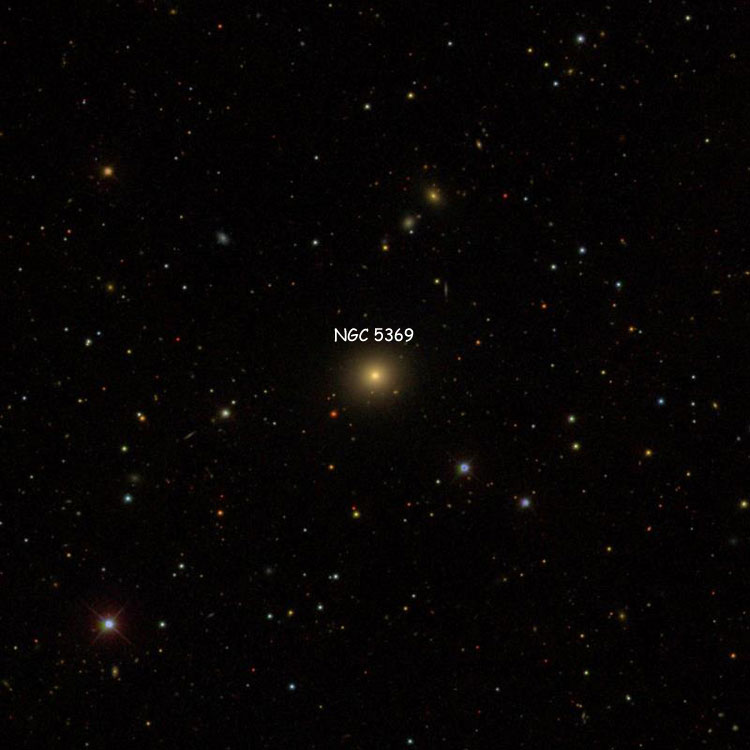
Above, a 12 arcmin wide SDSS image centered on NGC 5369
NGC 5370
(= PGC 49408 = UGC 8832 = CGCG 295-022 = MCG +10-20-044)
Discovered (Mar 19, 1790) by William Herschel
Also observed (Apr 14, 1831) by John Herschel
A magnitude 13.2 lenticular galaxy (type (R)SB(r)0?) in Ursa Major (RA 13 54 09.4, Dec +60 40 41)
Historical Identification: Per Dreyer, NGC 5370 (= GC 3709 = JH 1708 = WH II 843, 1860 RA 13 49 39, NPD 28 37.5) is "faint, small."
Physical Information:

Above, a 12 arcmin wide SDSS image centered on NGC 5370
SEE CORWIN NOTE FOR THIS OBJECT
NGC 5371 (probably = NGC 5390)
(= PGC 49514 = UGC 8846 = CGCG 219-029 = MCG +07-29-020)
Discovered (Jan 14, 1788) by William Herschel (and later listed as NGC 5371)
Also observed (May 16, 1831) by John Herschel (and later listed as NGC 5371)
Also observed (Apr 12, 1861) by Samuel Hunter (while listed as GC 3710)
Discovered (Mar 18, 1831) by John Herschel (and later listed as NGC 5390)
A magnitude 10.6 spiral galaxy (type SAB(rs)bc) in Canes Venatici (RA 13 55 39.9, Dec +40 27 42)
Historical Identification: Per Dreyer, NGC 5371 (= GC 3710 = JH 1707 = WH II 716, 1860 RA 13 49 47, NPD 48 49.7) is "pretty bright, large, round, brighter middle and faint nucleus".
Discovery Note: Per Gottlieb, the first suggestion that the galaxy might be a spiral was made by Hunter, using Lord Rosse's 72-inch "Leviathan".
Physical Information: Based on a recessional velocity of 2560 km/sec, NGC 5371 is about 120 million light years away, in good agreement with redshift-independent distance estimates of 105 to 125 million light years. Given that and its apparent size of 4.4 by 3.5 arcmin, it is about 150 thousand light years across. The core of the galaxy is relatively bright, and it is tentatively classified as a Seyfert galaxy (type Sy?). Given its more or less comparable distance, NGC 5371 is probably a wide member of the NGC 5353 galaxy group (the other members are also known as Hickson Compact Group 68).
Use By The de Vaucouleurs Atlas: NGC 5371 is used by the de Vaucouleurs Atlas of Galaxies as an example of type SAB(r s) bc.
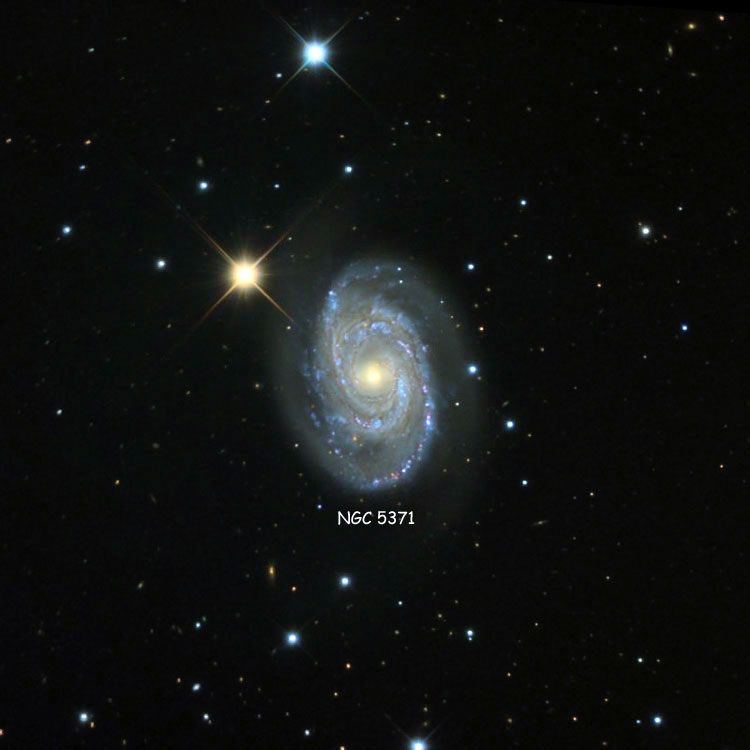
Above, a 12 arcmin wide image centered on NGC 5371
(Image Credit and © above and below: Jim Misti, Misti Mountain Observatory; used by permission)
Below, a 5 arcmin wide image of the galaxy

NGC 5372
(= PGC 49451 = UGC 8843 = CGCG 295-024 = MCG +10-20-046)
Discovered (Apr 24, 1789) by William Herschel
Also observed (May 1, 1831) by John Herschel
A magnitude 13.3 spiral galaxy (type SA(rs)c? pec) in Ursa Major (RA 13 54 46.0, Dec +58 40 01)
Historical Identification: Per Dreyer NGC 5372 (= GC 3711 = JH 1709 = WH III 809, 1860 RA 13 49 49, NPD 30 39.6) is "considerably faint, small, extended, double star involved?"
Physical Information: Apparent size of about 0.7 by 0.45 arcmin (from the images below).
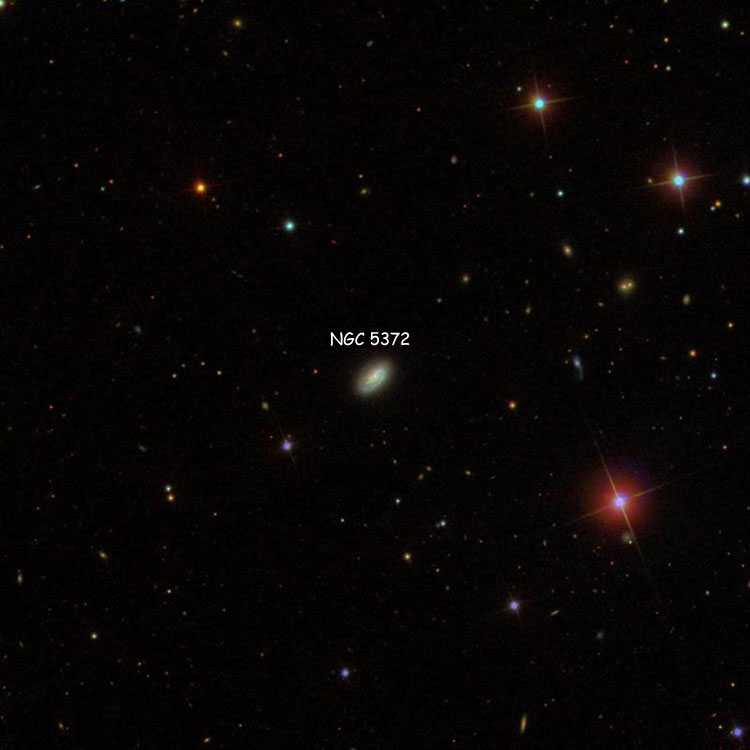
Above, a 12 arcmin wide SDSS image centered on NGC 5372
Below, a 0.9 arcmin wide SDSS image of the galaxy

NGC 5373
(= PGC 49620 = CGCG 046-014)
Discovered (May 8, 1864) by Albert Marth
Looked for but not found (May 5, 1897) by Guillaume Bigourdan (while listed as NGC 5373)
A magnitude 14.4 lenticular galaxy (type (R':)E/S0?) in Virgo (RA 13 57 07.5, Dec +05 15 07)
Historical Identification: Per Dreyer, NGC 5373 (= GC 5752, Marth #269, 1860 RA 13 50 05, NPD 84 03) is "very faint, very small, stellar."
Discovery Note: Gottlieb states that "Bigourdan could not find the galaxy (perhaps too faint)," and Gottlieb's own visual observation reads "extremely faint and small, round, low even surface brightness," making his suggestion that it was too faint for Bigourdan to see seem reasonable.
Physical Information:
Classification Note: The galaxy has a fairly bright extension of about 270° outside the central galaxy, from just south of west anti-clockwise to southeast forming a partial ring, while a fainter extension further out the rest of the way around (more obvious in the wide-field image) suggests a complete ring, but of unequal brightness, hence the colon following R'.
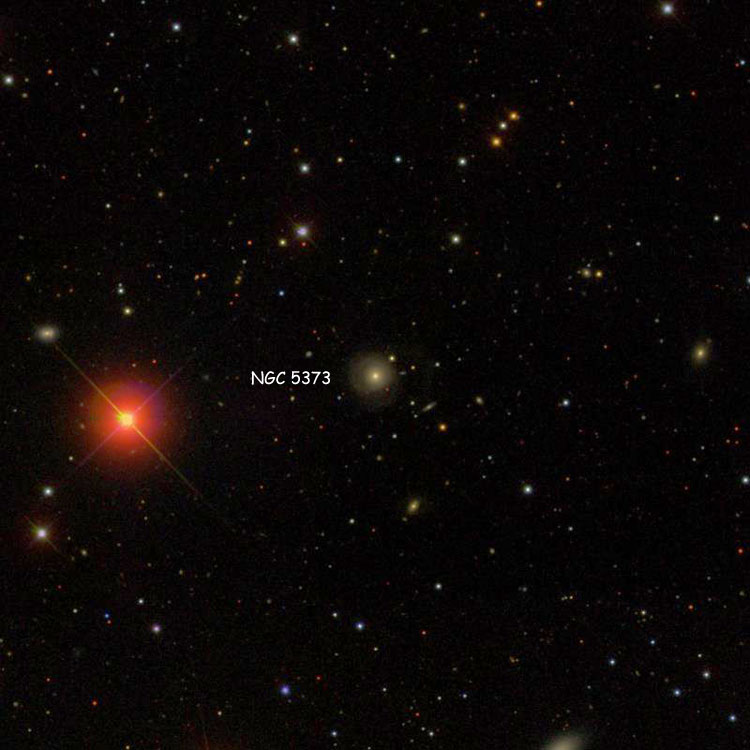
Above, a 12 arcmin wide SDSS image centered on NGC 5373
Below, a 1.2 arcmin wide SDSS image of the galaxy

NGC 5374
(= PGC 49650 = UGC 8874 = CGCG 046-016 = MCG +01-36-004)
Discovered (May 12, 1793) by William Herschel
Also observed (May 11, 1828) by John Herschel
A magnitude 12.5 spiral galaxy (type SBbc?) in Virgo (RA 13 57 29.6, Dec +06 05 49)
Historical Identification: Per Dreyer, NGC 5374 (= GC 3712 = JH 1710 = WH II 889, 1860 RA 13 50 29, NPD 83 12.9) is "considerably faint, pretty large, round, very gradually brighter middle, 11th magnitude star north-preceding (to northwest)."
Physical Information:

Above, a 12 arcmin wide SDSS image centered on NGC 5374
NGC 5375 (= NGC 5396)
(= PGC 49604 = UGC 8865 = CGCG 162-035 = MCG +05-33-027 = "PGC 5066607")
Discovered (May 16, 1784) by William Herschel (and later listed as NGC 5396)
Discovered (May 15, 1830) by John Herschel (and later listed as NGC 5375)
SEE CORWIN NOTE FOR THIS OBJECT
A magnitude 11.5 spiral galaxy (type SB(r)ab) in Canes Venatici (RA 13 56 56.0, Dec +29 09 52)
Historical Identification: Per Dreyer, NGC 5375 (= GC 3713 = JH 1711, 1860 RA 13 50 37, NPD 60 09.0) is "pretty bright, pretty large, round, a little brighter middle."
Discovery Note: Herschel suspected this was the same object observed by his father ( NGC 5396), but gave it a different entry in case he was wrong, and Dreyer followed his lead, leading to the duplicate entry.
Note About Second PGC Designation: A search of the LEDA database for NGC 5375 returns two results, both of which refer to NGC 5375, but with slightly different positions. The one labeled [MK2011]NGC5375 is assigned the useless PGC designation shown in quotes.
Physical Information:

Above, a 12 arcmin wide SDSS image centered on NGC 5375
NGC 5376
(= PGC 49489 = UGC 8852 = CGCG 295-025 = MCG +10-20-047)
Discovered (Apr 24, 1789) by William Herschel (and listed as I 238)
Rediscovered (Mar 19, 1790) by William Herschel (and listed as II 844)
A magnitude 12.1 spiral galaxy (type SBab?) in Ursa Major (RA 13 55 16.0, Dec +59 30 24)
Historical Identification: Per Dreyer, NGC 5376 (= GC 3714 = WH II 844 = GC 3715 = WH I 238, 1860 RA 13 50 37, NPD 29 48.4) is "considerably bright, pretty large, very little extended, very gradually much brighter middle."
Physical Information:
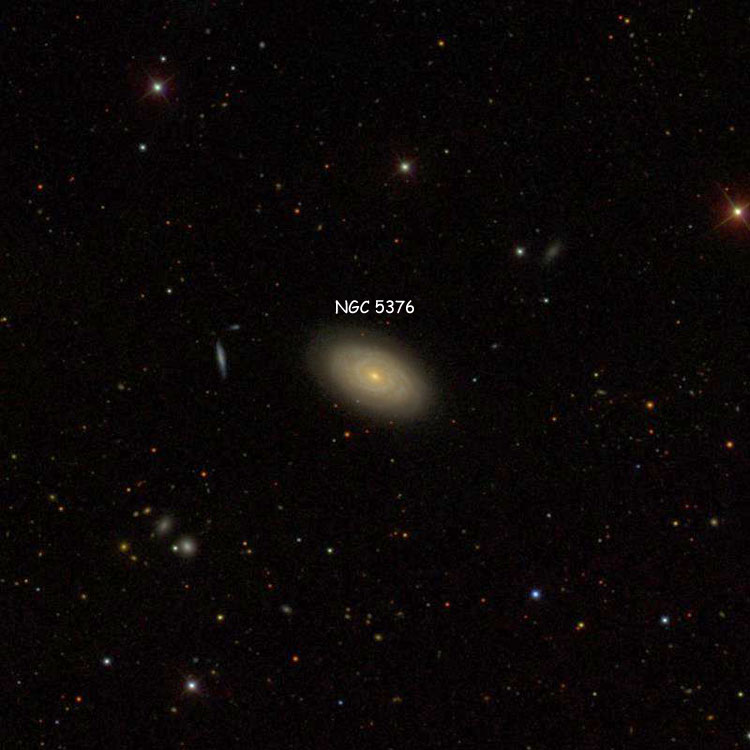
Above, a 12 arcmin wide SDSS image centered on NGC 5376
NGC 5377
(= PGC 49563 = UGC 8863 = CGCG 246-027 = MCG +08-25-052)
Discovered (May 12, 1787) by William Herschel
Also observed (Mar 20, 1828) by John Herschel
A magnitude 11.3 spiral galaxy (type (R1')SAB(s,nr)ab? pec) in Canes Venatici (RA 13 56 16.7, Dec +47 14 09)
Historical Identification: Per Dreyer, NGC 5377 (= GC 3716 = JH 1712 = WH I 187, 1860 RA 13 50 44, NPD 42 05.5) is bright, large, much extended 42°, suddenly much brighter middle and nucleus."
Physical Information: 4.7 by 2.5 arcmin (from the images below)
Classification Note: NGC 5377 is used by The de Vaucouleurs Atlas of Galaxies as an example of type R 1')SA B(rs)a, [A B indicating that although a barred galaxy, the "bar" is strange, and could be thought of as merely a peculiarity rather than a normal bar], with numerous notes discussing various features not indicated by that classification. For example, (R 1') indicates that the outer ring is created by spiral arms that meet halfway around the galaxy, to form a ring. The central "bar" is not aligned with, but at an angle to the overall structure, and according to the Atlas, a "deprojected" image shows that it is perpendicular to the outer ring; however, there are hints in both the images here and in the de Vaucouleurs images of a secondary bar at an angle to the more obvious one, typical of lenticular galaxies with "X"-shaped central structures (part of the reason for the A B, and for "pec"). A dusty central ring isn't obvious in the exaggerated image that shows bluish features associated with spiral structure, but is easy to see in the "normal" closeup, and is indicated by the "nr" for "nuclear ring" in my version of the "type". Overall, the galaxy has a more or less lens-shaped appearance, which is indicated in one of the notes for the Atlas by replacing (rs) by (l), but it seems better to simply note that here, than to add it to the type in the description line, which is already complex. I have also changed the final "a" to "ab?" to highlight the dramatic appearance of the outer arms. But no matter how it is classified, this is a spectacular galaxy.

Above, a 12 arcmin wide SDSS image centered on NGC 5377
Below, a 6 arcmin wide SDSS image of the galaxy

Below, the image above, altered to better show indications of spiral structure (Post-processing by Courtney Seligman)

NGC 5378
(= PGC 49598 = UGC 8869 = CGCG 191-020 = MCG +06-31-027)
Discovered (Mar 11, 1831) by John Herschel
A magnitude 12.5 spiral galaxy (type (R')SB(r)ab?) in Canes Venatici (RA 13 56 51.0, Dec +37 47 50)
Historical Identification: Per Dreyer, NGC 5378 (= GC 3717 = JH 1713, 1860 RA 13 50 47, NPD 51 31.6) is "pretty bright, a little extended, very gradually a little brighter middle."
Physical Information: LEDA SB(r)a; NED (R')SB(r)a, 3K Vr 3176 km/sec

Above, a 12 arcmin wide SDSS image centered on NGC 5378
NGC 5379
(= PGC 49508 = UGC 8860 = CGCG 295-026 = MCG +10-20-049)
Discovered (Apr 24, 1789) by William Herschel
A magnitude 12.9 lenticular galaxy (type (R)SB(r)0/a? pec) in Ursa Major (RA 13 55 34.3, Dec +59 44 34)
Historical Identification: Per Dreyer, NGC 5379 (= GC 3720 = WH I 239, 1860 RA 13 50 56, NPD 29 34.5) is "pretty bright, pretty small, extended, much brighter middle."
Physical Information: LEDA SB(r)0; NED S0, RIDE 12.9 - 28.3 (median 15.5) Mpc, 3K Vr 1877 km/sec
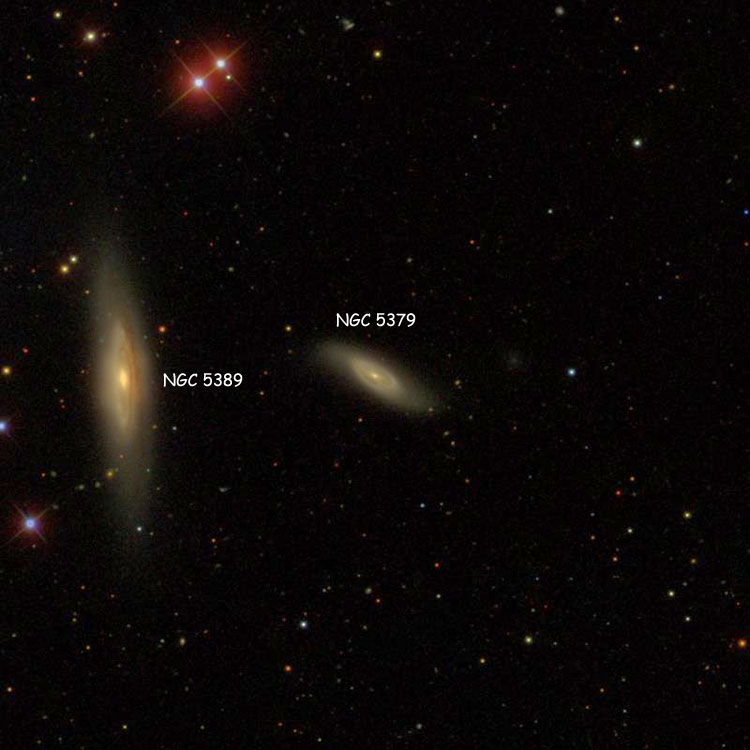
Above, a 12 arcmin wide SDSS image centered on NGC 5379, also showing NGC 5389
NGC 5380
(= PGC 49605 = PGC 2105148 = UGC 8870 = CGCG 191-021 = MCG +06-31-028)
Discovered (May 16, 1787) by William Herschel
Also observed (May 9, 1826) by John Herschel
A magnitude 12.3 lenticular galaxy (type (R)E/SA0?) in Canes Venatici (RA 13 56 56.7, Dec +37 36 37)
Historical Identification: Per Dreyer, NGC 5380 (= GC 3718 = JH 1714 = WH II 698, 1860 RA 13 50 57, NPD 51 42.3) is "faint, considerably small, round, suddenly much brighter middle."
Physical Information: LEDA (R)E/S0; NED E/SA0, RIDE 17.8 - 48.3 (median 36.5) Mpc, 3K Vr 3365 km/sec
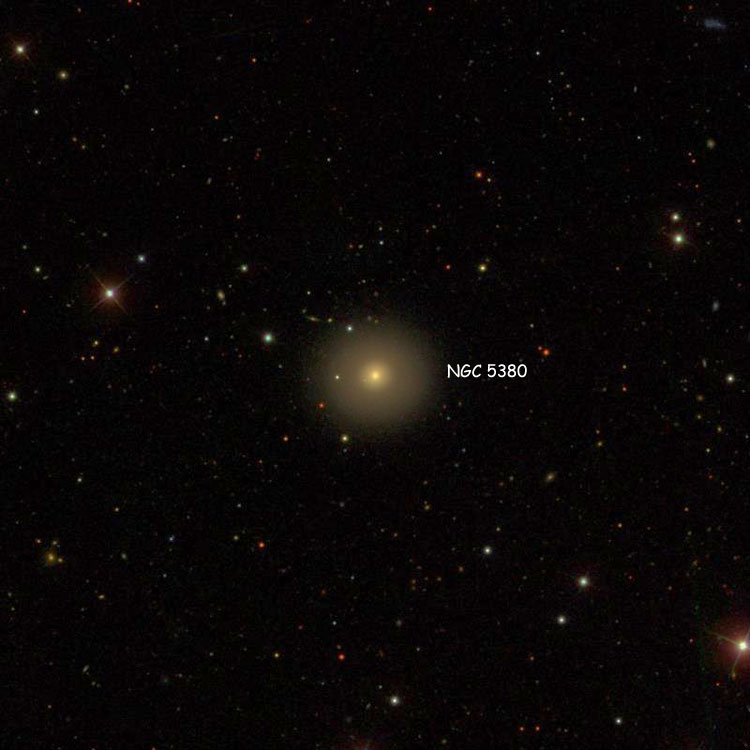
Above, a 12 arcmin wide SDSS image centered on NGC 5380
NGC 5381
(= OCL 915 = ESO 133-SC011 = "PGC 3518316")
Discovered (May 3, 1835) by John Herschel
An open cluster (type II2p) in Centaurus (RA 14 00 49.0, Dec -59 34 24)
Corwin lists the position of a star in(?) the cluster as RA 14 00 25.0, Dec -59 37 23
Historical Identification: Per Dreyer, NGC 5381 (= GC 3719 = JH 3549, 1860 RA 13 50 58, NPD 148 54.5) is "a cluster, rich, very compressed, pretty large, stars from 11th to 12th magnitude."
Note About PGC Designation: As for most NGC objects, HyperLEDA assigned a PGC designation to this object even though it isn't a galaxy; but a search of the database for that designation returns no result, so it is shown in quotes.
Physical Information:

Above, a 12 arcmin wide DSS image centered on NGC 5381
NGC 5382
(= PGC 49711 = UGC 8885 = CGCG 046-022 = MCG +01-36-007)
Discovered (Apr 29, 1786) by William Herschel
Also observed (May 9, 1828) by John Herschel
A magnitude 12.6 lenticular galaxy (type S0?) in Virgo (RA 13 58 14.9, Dec +06 15 31)
Historical Identification: Per Dreyer, NGC 5382 (= GC 3721 = JH 1715 = WH III 546, 1860 RA 13 51 16, NPD 83 03.7) is "very faint, very small, mottled but not resolved, stellar."
NGC Note: "There is no 'R. nova' near, only h 1710, h 1715, h 1716 seen at Birr. GC 3722 struck out."
Physical Information:

Above, a 12 arcmin wide SDSS image centered on NGC 5382, also showing NGC 5386
NGC 5383
(= PGC 49618 = UGC 8875 = CGCG 219-033 = MCG +07-29-023)
Discovered (Apr 9, 1787) by William Herschel
Also observed (May 6, 1828) by John Herschel
A magnitude 11.4 spiral galaxy (type (R')SB(rs)b? pec) in Canes Venatici (RA 13 57 05.0, Dec +41 50 46)
Historical Identification: Per Dreyer, NGC 5383 (= GC 3723 = JH 1717 = WH I 181, 1860 RA 13 51 18, NPD 47 28.3) is "considerably bright, considerably large, round, gradually brighter middle."
Physical Information: Apparent size of about 2.7 by 2.2 arcmin (from the image below); "type" from NED, subject to minor changes; but definitely a peculiar spiral galaxy
Below, a 3 arcmin wide SDSS image of the galaxy
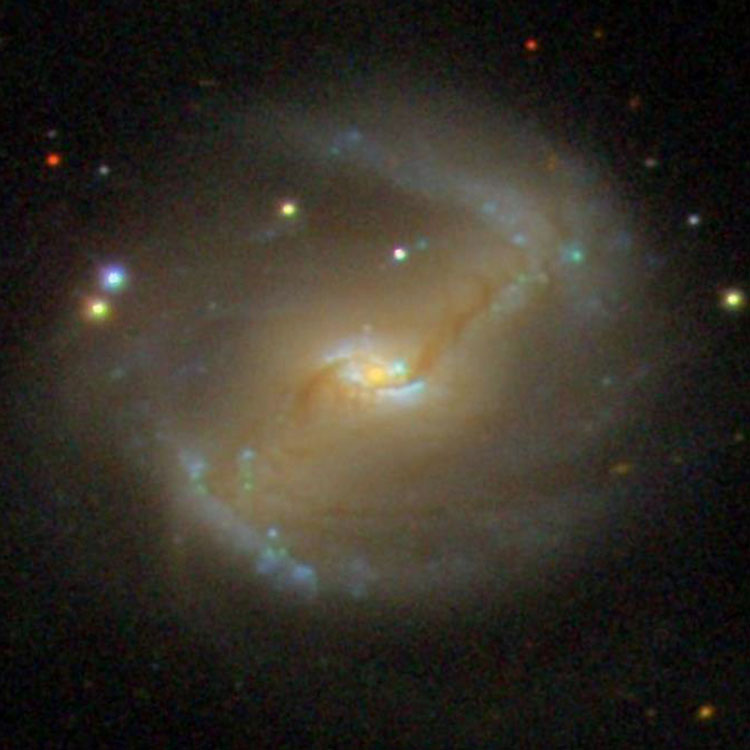
PGC 49624
(= UGC 8877 = MCG +07-29-022)
Not an NGC object but listed here as an apparent companion of NGC 5383
A magnitude 14.5(?) spiral galaxy (type SB(s)d?) in Canes Venatici (RA 13 57 07.0, Dec +41 47 35)
Physical Information: LEDA SBd, B 15.2; NED SBdm, 1.1 x 1.0 arcmin, 3K Vr 2555 km/sec
NGC 5384
(= PGC 49707 = UGC 8886 = CGCG 046-023 = MCG +01-36-008)
Discovered (May 8, 1864) by Albert Marth
A magnitude 13.1 lenticular galaxy (type (R)S(rs)0/a?) in Virgo (RA 13 58 12.9, Dec +06 31 05)
Historical Identification: Per Dreyer, NGC 5384 (= GC 5753, Marth #270, 1860 RA 13 51 18, NPD 82 49) is "faint, very small, stellar."
Physical Information: Apparent size of about 0.8 by 0.35 arcmin for the central galaxy and about 1.75 by 0.6 arcmin for the outer ring (from the image below).
Below, a 2 arcmin wide SDSS image of the galaxy

NGC 5385
(= "PGC 5067503")
Discovered (May 5, 1831) by John Herschel
SEE CORWIN NOTE FOR THIS OBJECT
A group of stars in Ursa Minor (RA 13 52 25.0, Dec +76 09 54)
Historical Identification: Per Dreyer, NGC 5385 (= GC 3724 = JH 1721, 1860 RA 13 51 19, NPD 13 08.0) is "a cluster, poor, small."
Note About PGC Designation: As for most NGC objects, HyperLEDA assigned a PGC designation to this object, even though it isn't a galaxy; but a search of the database for that designation returns no result so it is shown in quotes.
Physical Information: The radial velocities of the stars in the "cluster" are dissimilar, so this is not a real physical group, but merely (per Gottlieb) "a random enhancement of field stars." As a result, there is no "distance" or "physical size" that can be assigned to the "object". (Apparent size about 7 arcmin?)

Above, a 12 arcmin wide DSS image centered on NGC 5385
PGC 49199
Not an NGC object but listed here as an apparent companion of NGC 5385
A magnitude 16(?) lenticular galaxy (type E/S0?) in Ursa Minor (RA 13 51 39.2, Dec +76 08 28)
Physical Information: LEDA "galaxy" B 16.4; NED 3K Vr 12100 km/sec, z 0.04036005299768
NGC 5386
(= PGC 49719 = UGC 8890 = CGCG 046-024 = MCG +01-36-010)
Discovered (Apr 29, 1786) by William Herschel
Also observed (May 9, 1828) by John Herschel
A magnitude 13.2 spiral galaxy (type (R?)SAB(rs)ab? pec) in Virgo (RA 13 58 22.3, Dec +06 20 21)
Historical Identification: Per Dreyer, NGC 5386 (= GC 3725 = JH 1716 = WH III 547, 1860 RA 13 51 23, NPD 82 58.6) is "very faint, very small, binuclear, mottled but not resolved, stellar."
Physical Information: Apparent size of about 1.05 by 0.75 arcmin (from the image below); usual classification is lenticular (S0/a), but the image below shows that this is a peculiar spiral galaxy, as shown in the description line. (R?) indicates that the outer arms seem to form a ring around the central galaxy; better images (if available) may alter the classification. Probably an AGN (active galaxy nucleus) galaxy.
Below, a 1.2 arcmin wide SDSS image centered of NGC 5386

NGC 5387
(= PGC 49724 = UGC 8891 = CGCG 046-026 = MCG +01-36-011)
Discovered (May 8, 1864) by Albert Marth
A magnitude 13.9 spiral galaxy (type Sbc?) in Virgo (RA 13 58 24.8, Dec +06 04 16)
Historical Identification: Per Dreyer, NGC 5387 (= GC 5754, Marth #271, 1860 RA 13 51 24, NPD 83 15) has "a very faint ray, 2 arcmin long".
Physical Information: Apparent size of about 1.6 by 0.25 arcmin (from the image below)
Below, a 1.75 arcmin wide SDSS image of NGC 5387

NGC 5388
(= "PGC 5067504")
Recorded (May 4, 1886) by Frank Muller
SEE CORWIN NOTE FOR THIS OBJECT
A lost or nonexistent object in Virgo (RA 13 58 56, Dec -14 09.1) ???
Historical Identification: Per Dreyer, NGC 5388 (Muller list I (#199), 1860 RA 13 51 25, NPD 103 28.1) is "faint, small, round, very gradually brighter middle."
Note About PGC Designation: As for most NGC objects, HyperLEDA assigned a PGC designation to this object, even though it isn't a galaxy; but a search of the database for that designation returns no result so it is shown in quotes.
NGC 5389
(= PGC 49548 = UGC 8866 = CGCG 295-027 = MCG +10-20-051)
Discovered (Apr 24, 1789) by William Herschel
Also observed (Apr 14, 1831) by John Herschel
A magnitude 12.0 spiral galaxy (type SAB(r)a) in Ursa Major (RA 13 56 06.3, Dec +59 44 31)
Historical Identification: Per Dreyer, NGC 5389 (= GC 3726 = JH 1719 = WH I 240, 1860 RA 13 51 30, NPD 29 34.3) is "pretty bright, pretty large, extended, much brighter middle and nucleus."
Physical Information: Apparent size of about 1.55 by 0.5 arcmin for the central galaxy and about 4.2 by 1.0 arcmin for the faint north-south extensions (from the image below). Typically classified as lenticular SB(r)0/a, and there is no sign of spiral structure, as such; but the unusually dusty rings suggest that this is as likely or more likely to be a very early type spiral gradually turning into a lenticular galaxy but not quite there yet as a result of some past merger or gravitational interaction. Corwin agrees with this argument, and provided the type shown in the description line.
Below, a 2.5 by 4.5 arcmin wide SDSS image of NGC 5389
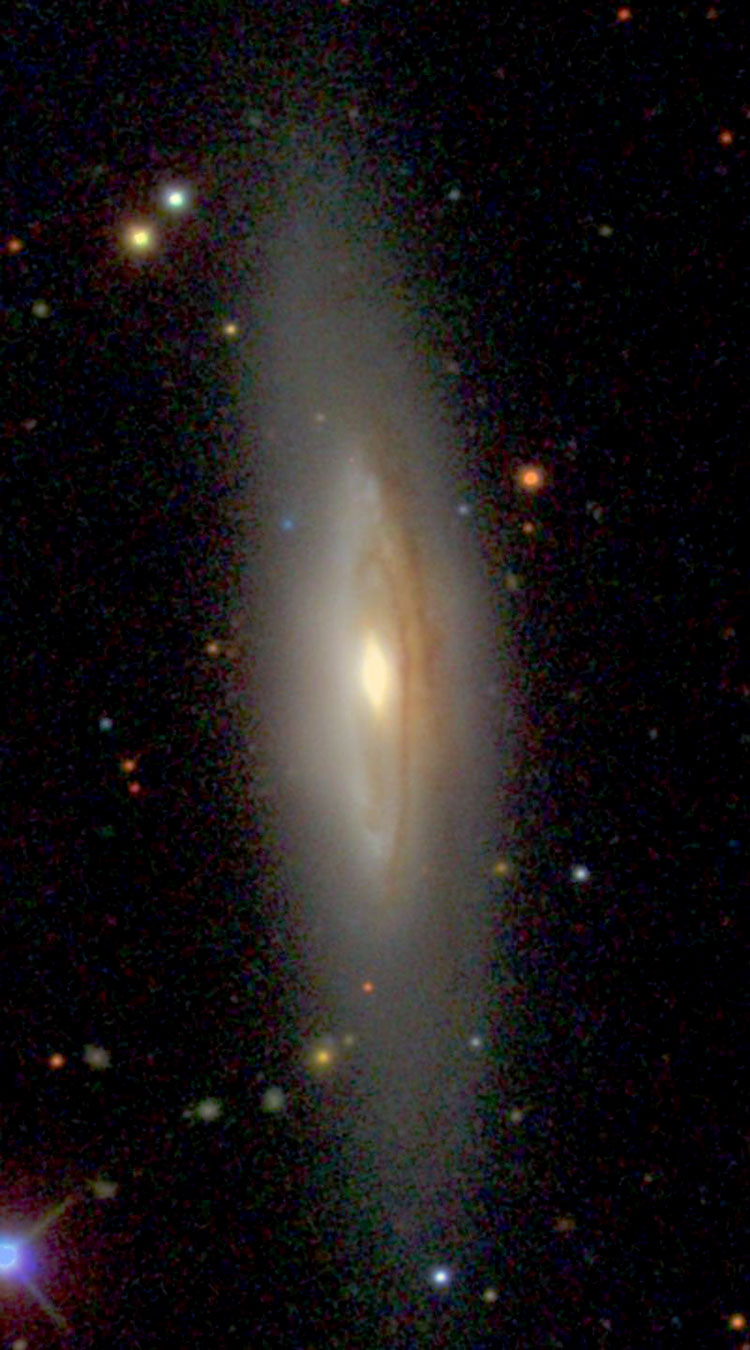
NGC 5390 (almost certainly = NGC 5371)
(= PGC 49514 = UGC 8846 = CGCG 219-029 = MCG +07-29-020)
Discovered (Jan 14, 1788) by William Herschel (and later listed as NGC 5371)
Discovered (Mar 18, 1831) by John Herschel (and later listed as NGC 5390)
A magnitude 10.6 spiral galaxy (type SAB(rs)bc) in Canes Venatici (RA 13 55 39.9, Dec +40 27 42)
SEE CORWIN NOTE FOR THIS OBJECT
Historical Identification: Per Dreyer, NGC 5390 (= GC 3727 = JH 1718, 1860 RA 13 51 31, NPD 48 52.6) is "faint, large, very gradually brighter middle, 9th magnitude star north-following (to northeast)."
Discovery Note: Gottlieb points out that there is nothing at JH's position (marked as uncertain), but that NGC 5371 is only 1.7 minutes of right ascension to the west and fits the description. He adds that Karl Reinmuth reported "no L neb and no *9 nf found; = N5371?", and "See Corwin's notes."
Physical Information: Given the presumed duplicate entry, see NGC 5371 for anything else.
NGC 5391
Recorded (Jun 16, 1884) by Lewis Swift
A lost or nonexistent object in Canes Venatici (RA 13 57 38.0, Dec +46 19 29)
Historical Identification: Per Dreyer, NGC 5391 (Swift list I (#26), 1860 RA 13 52 03, NPD 42 59.5) is "faint, very small, star close." The position precesses to RA 13 57 38.0, Dec +46 19 29 (whence the position shown above), but there is nothing there, and nothing near there that fits Swift's description. Despite that, HyperLEDA and RNGC (both of which have numerous errors) list PGC 49609 as NGC 5391, so it is discussed in the following entry, and another galaxy ( PGC 2281757) formerly suggested by Corwin as a possible candidate is discussed in the entry after that. However, for the reasons discussed in those entries, neither of them is likely to be what Swift observed, and NGC 5391 is almost certainly lost or nonexistent.
Physical Information: In the absence of any reasonable identification, there is nothing to discuss.
Above, a 12 arcmin wide SDSS image centered on the NGC position for NGC 5391; also (barely) shown is PGC 49609
PGC 49609 (almost certainly not NGC 5391)
(= MCG +08-25-054)
Not an NGC object but listed here because often misidentified as NGC 5391
A magnitude 15.5(?) spiral galaxy (type Sbc?) in Canes Venatici (RA 13 57 04.7, Dec +46 15 51)
Historical Misidentification:
Physical Information: 0.7 by 0.3 arcmin (from the image below)
LEDA Sbc, B 16.05, I 14.73 -> V 15.5(?); NED "This is almost certainly not NGC 5391.", Sb, 15.8g, 3K Vr 16556 km/sec, z 0.055224362017
Below, a 1 arcmin wide SDSS image of PGC 49609

PGC 2281757 (almost certainly not NGC 5391)
(= PGC 2281789)
Not an NGC object but listed here because sometimes misidentified as NGC 5391
A magnitude 16(?) lenticular galaxy (type E/S0?) in Canes Venatici (RA 13 57 42.8, Dec +46 28 11)
Historical Misidentification:
Physical Information:
LEDA E, B 16.42, I 14.87 -> V 16(?); NED RIDE1 272 Mpc, 16.3g, 3K Vr 19007 km/sec, z 0.06340103549
Below, a ? arcmin wide SDSS image of PGC 2281757

NGC 5392
(= PGC 49792 = CGCG 018-013 = MCG +00-36-005)
Discovered (Apr 15, 1787) by William Herschel
Also observed (Apr 15, 1828) by John Herschel
A magnitude 13.4 lenticular galaxy (type S(r)0/a? pec) in Virgo (RA 13 59 24.8, Dec -03 12 33)
Historical Identification: Per Dreyer, NGC 5392 (= GC 3728 = JH 1720 = WH III 666, 1860 RA 13 52 11, NPD 92 31.4) is "very faint, considerably small, round, gradually brighter middle."
NGC Note: "Per JH, h 1720 = III 666. Auwers, finding H - h = +52 seconds in RA, supposes a mistake of 1 minute [by WH]. Examined sweep 146 (h) and found all clearly writen and correctly reduced."
Error Note: Gottlieb states that the position in the RNGC is "exactly 2.0 min too large (probably a typo)."
Physical Information: Per NED, the object to the northeast of the nucleus is part of NGC 5392, presumably making this a binuclear lenticular galaxy (most likely, two galaxies in a late stage of merging into a single galaxy).
Apparent size of about 0.9 by 0.5 arcmin (from the images below)
NED 3K Vr 7614 km/sec, z 0.025397639

Above, a 12 arcmin wide SDSS image centered on NGC 5392
Below, a 1.5 arcmin wide SDSS image of NGC 5392

Corwin lists the position of (NED SDSS J135925.19-031228.9 = "PGC 5950897") as RA 13 59 25.2, Dec -03 12 29
(Listed in NED as part of NGC 5392, in which case NGC 5392 would be binuclear
but it is listed in LEDA as a probable "companion"
LEDA E, 1.0 by 0.55 = E4-5, 3K Vr 7724 km/sec, B 16.06, I 14.49, -> V 16.5 - 17 (16.7?)
NGC 5393
(= PGC 49863 = ESO 445-087 = MCG -05-33-035)
Discovered (Mar 30, 1835) by John Herschel
SEE CORWIN NOTE FOR THIS OBJECT
A magnitude 13.0 spiral galaxy (type (R')SAB(rs)bc) in Hydra (RA 14 00 32.1, Dec -28 52 28)
Historical Identification: Per Dreyer, NGC 5393 (= GC 3729 = JH 3550, 1860 RA 13 52 33, NPD 118 11.3) is "very faint, small, round, gradually a little brighter middle."
Physical Information: Apparent size 0.8 by 0.7 arcmin.(from the image below)
Below, a 1.25 arcmin wide PanSTARRS image of NGC 5393

NGC 5394 (with NGC 5395 = Arp 84, the Heron Galaxy)
(= PGC 49739 = UGC 8898 = CGCG 191-024 = MCG +06-31-033)
Discovered (May 16, 1787) by William Herschel
Also observed (Apr 28, 1827) by John Herschel
Also observed (Apr 24, 1854 - Apr 17, 1855) by R. J. Mitchell
and (Apr 17, 1855) by George (Johnstone) Stoney
A magnitude 13.0 spiral galaxy (type SB(s)b? pec) in Canes Venatici (RA 13 58 33.6, Dec +37 27 13)
Historical Identification: Per Dreyer, NGC 5394 (= GC 3730 = JH 1722 = WH I 191, 1860 RA 13 52 35, NPD 51 52.1) is "considerably faint, small, north-preceding (northwestern) of 2," the other being NGC 5395, with which it comprises Arp 84.
Discovery Note: Gottlieb notes that the pair of galaxies was observed several times with the 72-inch telescope at Birr Castle, though the observations were recorded under GC 3717 (= NGC 5378). R. J. Mitchell was the principle observer, making detailed notes indicating that both galaxies were seen as well as several of the features of their visual appearance, on Apr 24, 1854, May 1, 1854, Feb 18, 1855, and (while Johnstone Stoney was visiting and therefore also observed the nebulae) on Apr 17, 1855, hence my addition of their names to the list of observers.
Physical Information: NGC 5394 and 5395 are an interacting pair of spiral galaxies, also known as Arp 84. As discussed at the entry for NGC 5395, their recessional velocities imply a distance of about 160 million light years. Given that and its apparent size of 1.9 by 1.3 arcmin, NGC 5394 is about 90 thousand light years across.

Above, a 12 arcmin wide SDSS image centered on NGC 5394 and 5395, also showing IC 4356
Below, a 2.4 arcmin wide SDSS image of NGC 5394 and part of NGC 5395

PGC 2101092
Not an NGC object but listed here as an apparent companion of NGC 5394
A magnitude 17.5(?) spiral galaxy (type S?) in Canes Venatici (RA 13 58 26.2, Dec +37 27 09)
Physical Information: LEDA Sd, B 17.8, I 16.7 -> V 17.5(?); NED .48 x .12 arcmin, 3K Vr 15075 km/sec, z 0.05028646
NGC 5395 (with NGC 5394 = Arp 84, the Heron Galaxy)
(= PGC 49747 = UGC 8900 = CGCG 191-026 = MCG +06-31-034)
Discovered (May 16, 1787) by William Herschel
Also observed (May 9, 1826) by John Herschel
Also observed (Apr 24, 1854 - Apr 17, 1855) by R. J. Mitchell
and (Apr 17, 1855) by George (Johnstone) Stoney
A magnitude 11.4 spiral galaxy (type SA(s)b? pec) in Canes Venatici (RA 13 58 38.0, Dec +37 25 28)
Historical Identification: Per Dreyer, NGC 5395 (= GC 3731 = JH 1723 = WH I 190, 1860 RA 13 52 38, NPD 51 53.9) is "considerably faint, considerably large, extended 15°, a little brighter middle, south-following (southeastern) of 2," the other being NGC 5394, with which it comprises Arp 84.
Discovery Note: Gottlieb notes that the pair of galaxies was observed several times with the 72-inch telescope at Birr Castle, though the observations were recorded under GC 3717 (= NGC 5378). R. J. Mitchell was the principle observer, making detailed notes indicating that both galaxies were seen as well as several of the features of their visual appearance, on Apr 24, 1854, May 1, 1854, Feb 18, 1855, and (while Johnstone Stoney was visiting and therefore also observed the nebulae) on Apr 17, 1855, hence my addition of their names to the list of observers.
Physical Information: NGC 5395 and 5394 are an interacting pair of spiral galaxies, also known as Arp 84. Even without their nearly identical recessional velocities (3510 km/sec for NGC 5395 and 3450 km/sec for NGC 5394) their obvious interaction would make it clear that they are at the same distance. Based on their recessional velocities, that distance is about 160 million light years. Given that and its apparent size of 3.0 by 1.3 arcmin, NGC 5395 is about 140 thousand light years across. It is a Seyfert galaxy (type Sy 2).

Above, a 12 arcmin wide SDSS image centered on NGC 5395 and 5394, also showing IC 4356
Below, a 3.6 arcmin wide SDSS image of NGC 5395
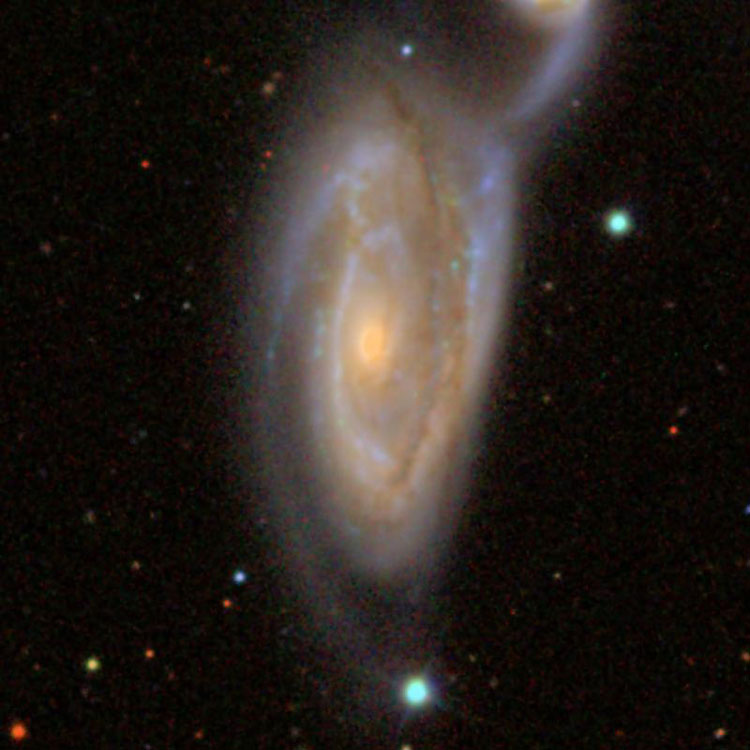
Below, a 3.0 by 4.5 arcmin wide SDSS image of Arp 84

NGC 5396 (= NGC 5375)
(= PGC 49604 = UGC 8865 = CGCG 162-035 = MCG +05-33-027 = "PGC 5066607")
Discovered (May 16, 1784) by William Herschel (and later listed as NGC 5396)
Discovered (May 15, 1830) by John Herschel (and later listed as NGC 5375)
SEE CORWIN NOTE FOR THIS OBJECT
A magnitude 11.5 spiral galaxy (type SB(r)ab) in Canes Venatici (RA 13 56 56.0, Dec +29 09 52)
Historical Identification: Per Dreyer, NGC 5396 (= GC 3732 = WH III 125, 1860 RA 13 52 39, NPD 60 11.5) is "very faint, small, irregularly round, suddenly brighter middle like a star."
Historical Note: William Herschel's position was poor, and although John suspected their observations were of the same object he gave them different listings, in case he was wrong; and Dreyer followed his lead, hence the double listing. However, in his 1912 paper Dreyer suggested that NGC 5396 and 5375 were the same object, so the duplicate entry was suspected early on.
Note About Second PGC Designation: A search of the LEDA database for NGC 5396 returns two results, both of which refer to NGC 5375, but with slightly different positions. The one labeled [MK2011]NGC5375 is assigned the useless PGC designation shown in quotes.
Physical Information: Based on a recessional velocity of 2385 km/sec, NGC 5396 (= NGC 5375) is about 110 million light years away, in reasonable agreement with a redshift-independent distance estimate of 125 million light years. Given that and its apparent size of 3.2 by 2.8 arcmin, it is about 110 thousand light years across.

Above, a 12 arcmin wide SDSS image centered on NGC 5396, also known as NGC 5375
Below, a 3.6 arcmin wide SDSS image of the galaxy
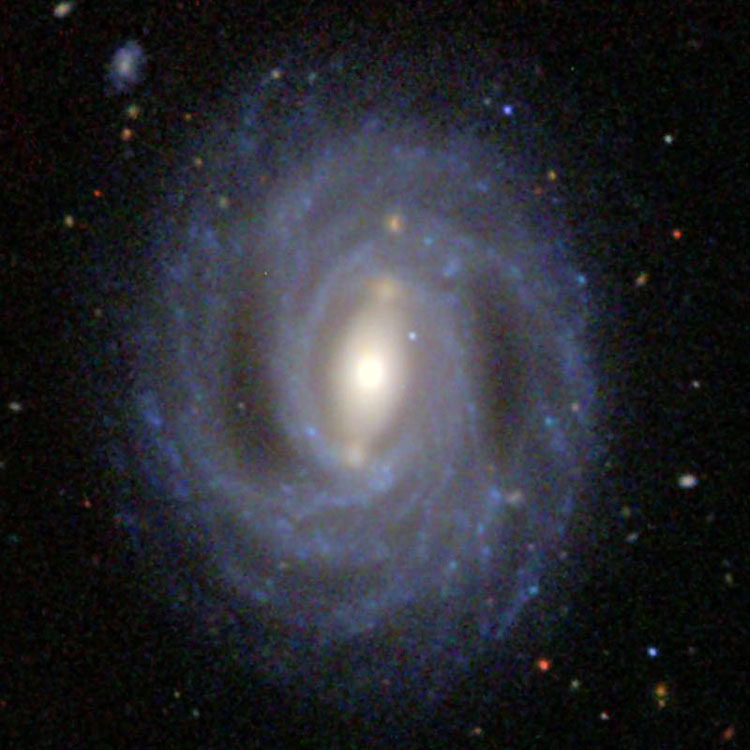
NGC 5397
(= PGC 49908 = ESO 384-031 = MCG -06-31-013)
Discovered (Jun 8, 1837) by John Herschel
A magnitude 11.6 lenticular galaxy (type SAB0/a?) in Centaurus (RA 14 01 10.5, Dec -33 56 45)
Historical Identification: Per Dreyer, NGC 5397 (= GC 3733 = JH 3551, 1860 RA 13 52 56, NPD 123 16.4) is "very faint, small, round, gradually brighter middle." The position precesses to RA 14 01 07.1, Dec -33 57 13, about 0.8 arcmin southwest of the center of the galaxy listed above, the description fits and there is nothing else nearby, so the identification is certain.
Physical Information: Based on a recessional velocity relative to the Cosmic Microwave Background radiation of 4410 km/sec (and H0 = 70 km/sec/Mpc), NGC 5397 is about 205 million light-years away, in good agreement with redshift-independent distance estimates of about 145 to 275 million light-years. Given that and its apparent size of about 1.05 by 0.7 arcmin (from the images below), the galaxy is about 60 to 65 thousand light-years across.
Classification Note: Neither of the images below seems to agree with either of the listed types. There is no sign of spiral structure, as suggested by the NED classification (E/SAB(s)0?), but the structure is definitely more complex than would be expected from the LEDA classification (E/SB0); and the exceptionally bright nucleus suggests that something interesting is going on that we just can't see, so I have used a typical classification for a galaxy that is on the border between lenticular and spiral structure.

Above, a 12 arcmin wide DSS image centered on NGC 5397
Below, a 1.5 arcmin wide DSS image of the galaxy

NGC 5398
(= PGC 49923 = UGCA 379 = ESO 384-032 = MCG -05-33-037 = AM 1358-324)
Discovered (Jun 3, 1836) by John Herschel
A magnitude 12.2 spiral galaxy (type (R)SB(s)dm? pec) in Centaurus (RA 14 01 21.8, Dec -33 03 44)
Historical Identification: Per Dreyer, NGC 5398 (= GC 3734 = JH 3552, 1860 RA 13 53 11, NPD 122 23.3) is "pretty bright, pretty large, round, very gradually brighter middle." The position precesses to RA 14 01 20.2, Dec -33 04 05, on a bright knot (a star-forming region) on the western side of the galaxy listed above, the description fits and there is nothing else nearby, so the identification is certain.
Arp-Madore Designation: NGC 5398 is listed in the Arp-Madore Catalogue of Southern Peculiar Galaxies & Associations as a spiral galaxy with apparent companions, but is not one of the galaxies discussed in any detail.
Physical Information: Based on a recessional velocity of 1220 km/sec (and H0 = 70 km/sec/Mpc), NGC 5398 is about 55 to 60 million light years away, in good agreement with widely varying redshift-independent distance estimates of about 20 to 60 million light years (the HST press release quotes 55 million light years). Given that and its apparent size of about 3.3 by 1.8 arcmin (from the images below), it is about 55 thousand light years across. The star-forming region on the galaxy's southwestern rim (which corresponds to Herschel's position for the object) is about 5000 by 4000 light years across, and contains at least seven young star clusters. The two brightest clumps (called Tol 89A and 89B) represent bursts of star formation about 4 million and less than 3 million years ago, respectively. Tol 89A is thought to contain numerous Wolf-Rayet stars, which are exceptionally bright stars characterized by very high temperatures and extreme stellar winds. But since we see the galaxy as it was about 55 million years ago, such massive stars must have all gone supernova during the time it took their light to reach us, and only their "dead" remnants remain.
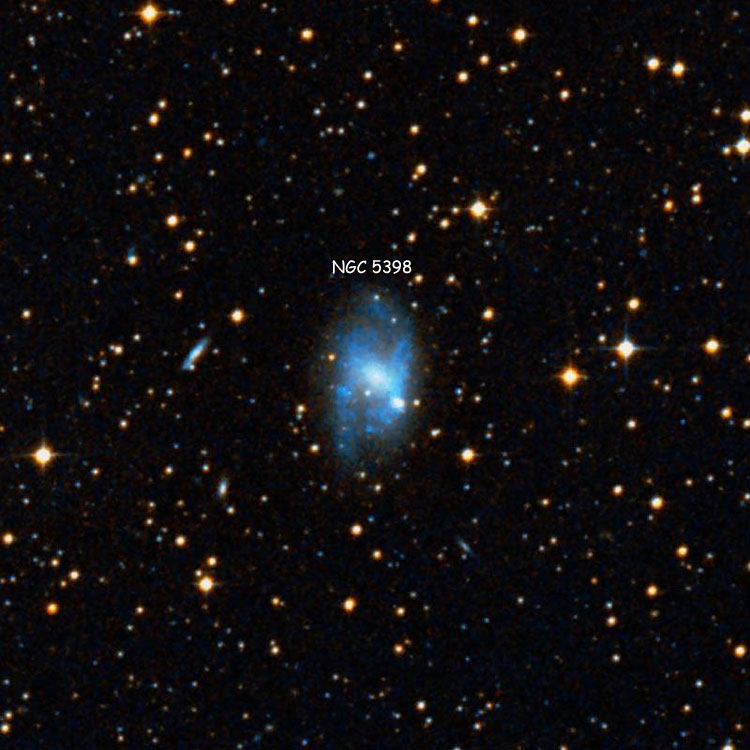
Above, a 12 arcmin wide DSS image centered on NGC 5398
Below, a 3.6 arcmin wide DSS image of the galaxy

Below, a 1.5 by 2.25 arcmin wide HST image of the central portion of the galaxy
(Image Credit ESA/Hubble & NASA)
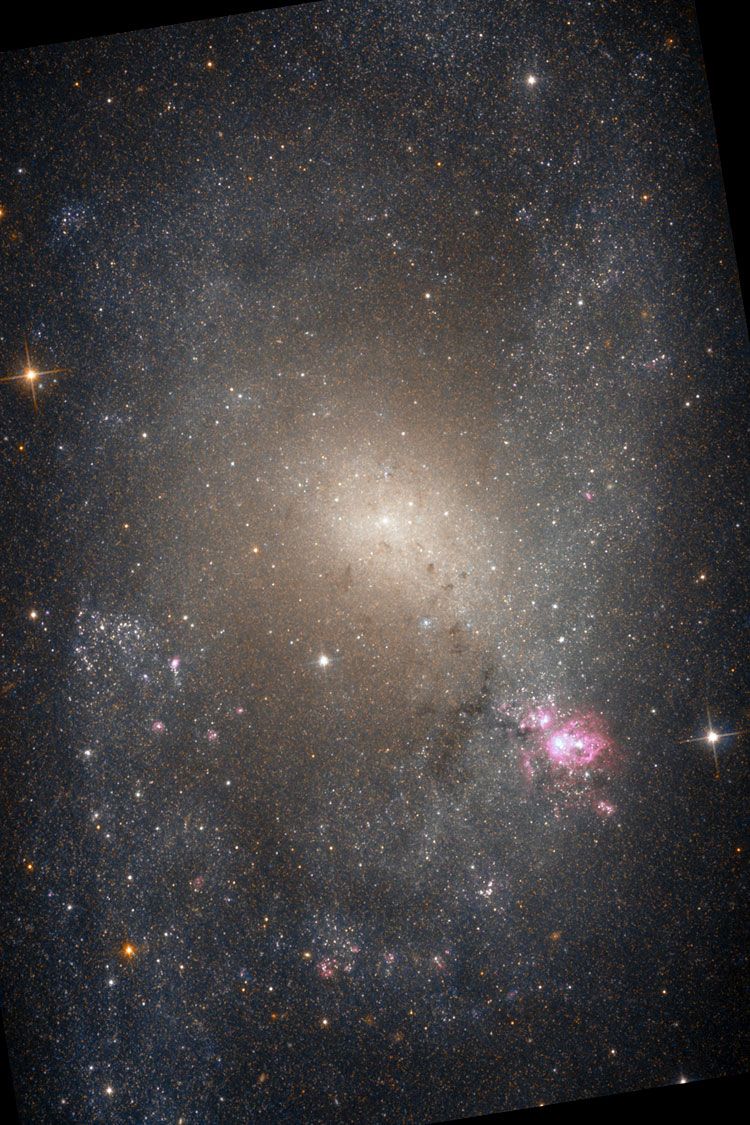
PGC 89817
Not an NGC object but listed here as an apparent companion of NGC 5398
A magnitude 16(?) spiral galaxy (type S? sp) in Centaurus (RA 14 01 35.5, Dec -33 03 22)
Physical Information: LEDA S?, B 16.63, I 14.64 => V 16(?); NED S0, .8 arcmin, 3K Vr 11500 km/sec, z 0.0383599
NGC 5399
(= PGC 49799 = UGC 8912 = CGCG 191-027 = MCG +06-31-039)
Discovered (May 1, 1785) by William Herschel
Also observed (Apr 24, 1827) by John Herschel
A magnitude 13.9 spiral galaxy (type Sbc?) in Canes Venatici (RA 13 59 31.4, Dec +34 46 25)
Historical Identification: Per Dreyer, NGC 5399 (= GC 3735 = JH 1724 = WH III 411, 1860 RA 13 53 25, NPD 54 32.6) is "extremely faint, very small, pretty much extended 90°."
Physical Information: Based on a recessional velocity relative to the Cosmic Microwave Background radiation of 3860 km/sec (and H0 = 70 km/sec/Mpc), NGC 5399 is about 180 million light-years away, in good agreement with redshift-independent distance estimates of about 175 to 245 million light-years. Given that and its apparent size of about 1.35 by 0.35 arcmin (from the images below), the galaxy is about 70 thousand light-years across.
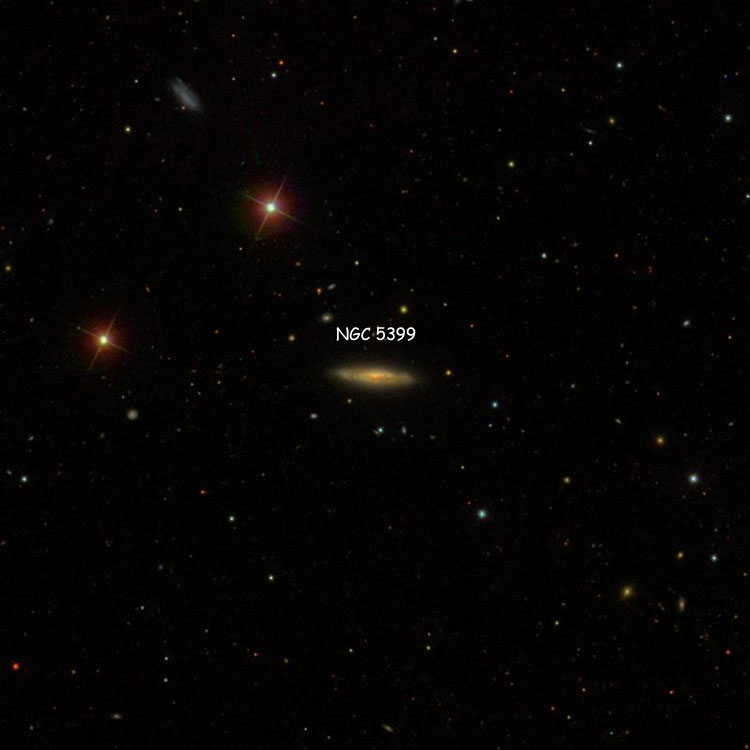
Above, a 12 arcmin wide SDSS image centered on NGC 5399
Below, a 2 arcmin wide SDSS image of the galaxy

|